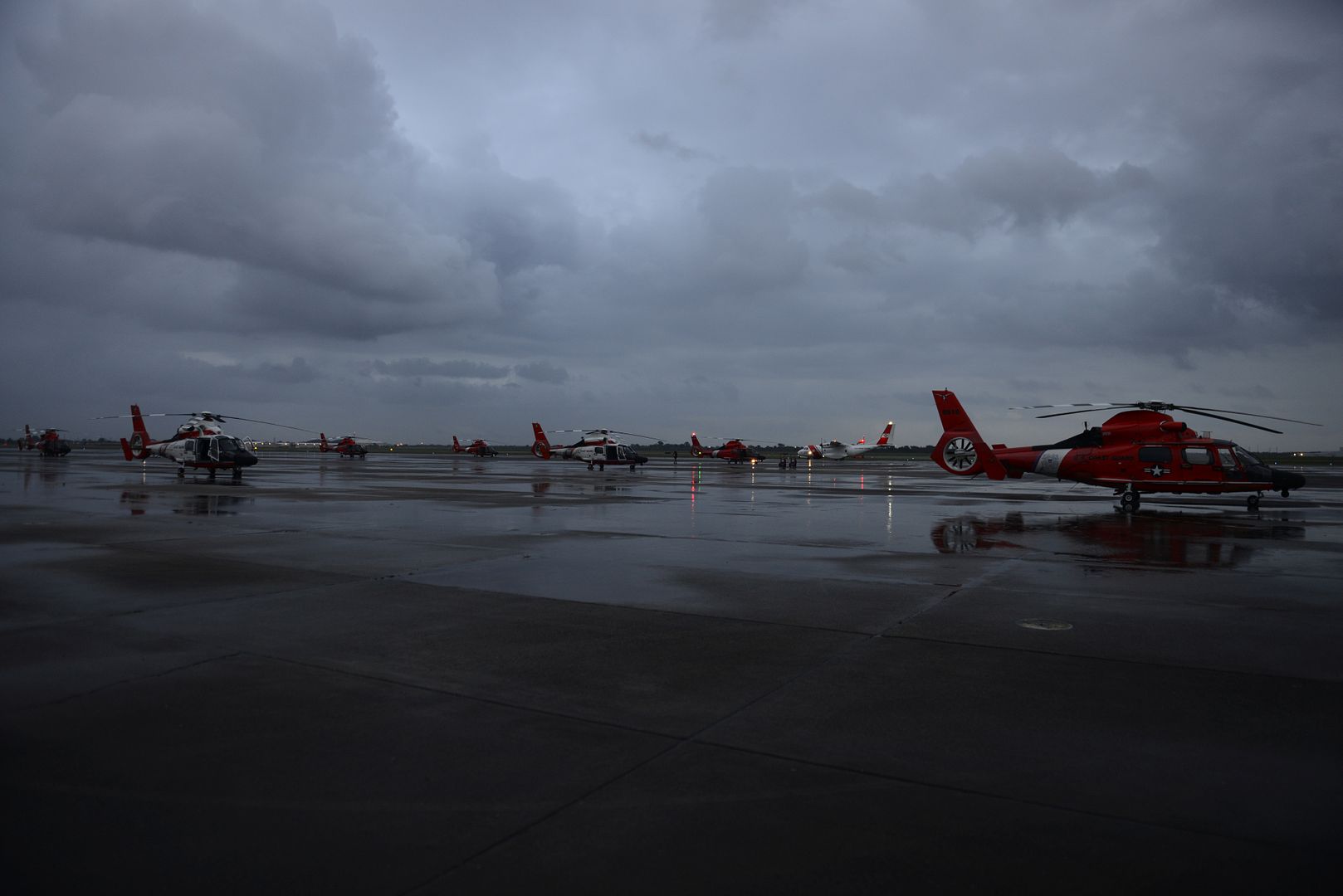Forums
- Forums
- Axis And Allies Forum
- General Discussion
- Aviation News
Aviation News
Post a reply
- Go to Previous topic
- Go to Next topic
- Go to Welcome
- Go to Introduce Yourself
- Go to General Discussion
- Go to Screenshots, Images and Videos
- Go to Off topic
- Go to Works in Progress
- Go to Skinning Tips / Tutorials
- Go to Skin Requests
- Go to IJAAF Library
- Go to Luftwaffe Library
- Go to RAF Library
- Go to USAAF / USN Library
- Go to Misc Library
- Go to The Ops Room
- Go to Made in Germany
- Go to Campaigns and Missions
- Go to Works in Progress
- Go to Juri's Air-Raid Shelter
- Go to Campaigns and Missions
- Go to Works in Progress
- Go to Skinpacks
- Go to External Projects Discussion
- Go to Books & Resources
-
 Main AdminPennsylvania Air National Guardsmen participate in the Nuclear Operational Readiness Inspection at the 171st Air Refueling Wing located near Pittsburgh Pennsylvania 19 Aug., 2017. (U.S. Air National Guard Photo by Airman 1st Class Kyle Brooks)
Main AdminPennsylvania Air National Guardsmen participate in the Nuclear Operational Readiness Inspection at the 171st Air Refueling Wing located near Pittsburgh Pennsylvania 19 Aug., 2017. (U.S. Air National Guard Photo by Airman 1st Class Kyle Brooks)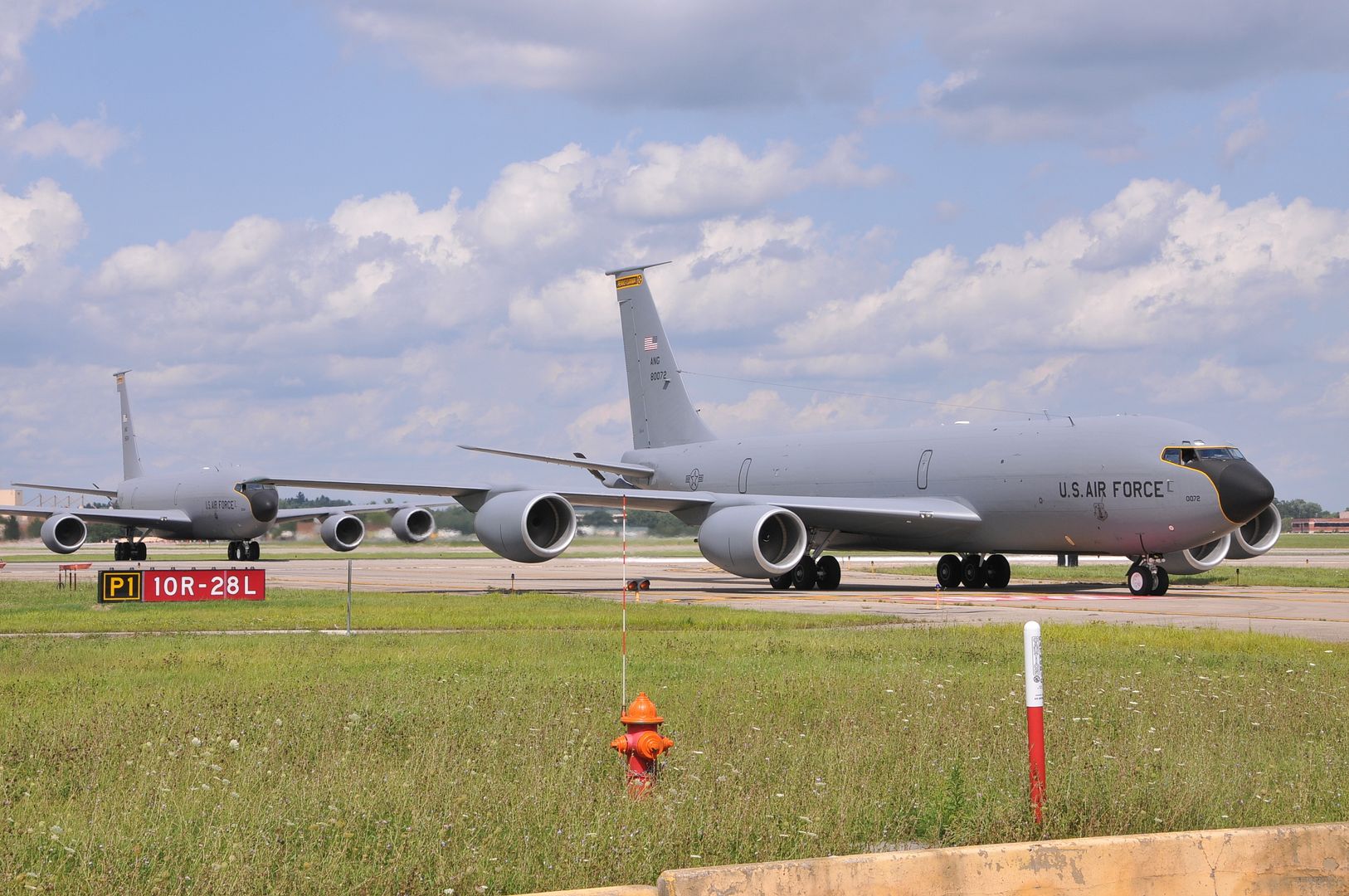
Civilian employers of 122nd Fighter Wing Air National Guard members were recognized during an annual Boss Lift flight at Grissom Air Reserve Base, Indiana on August 18, 2017. The flight, which involved the in air refueling of an A-10C fighter jet, was part of a series of activities meant to acknowledge employers for their support of their military employees and their unit. (U.S. Air National Guard photo by Senior Airman Justin Andras/Released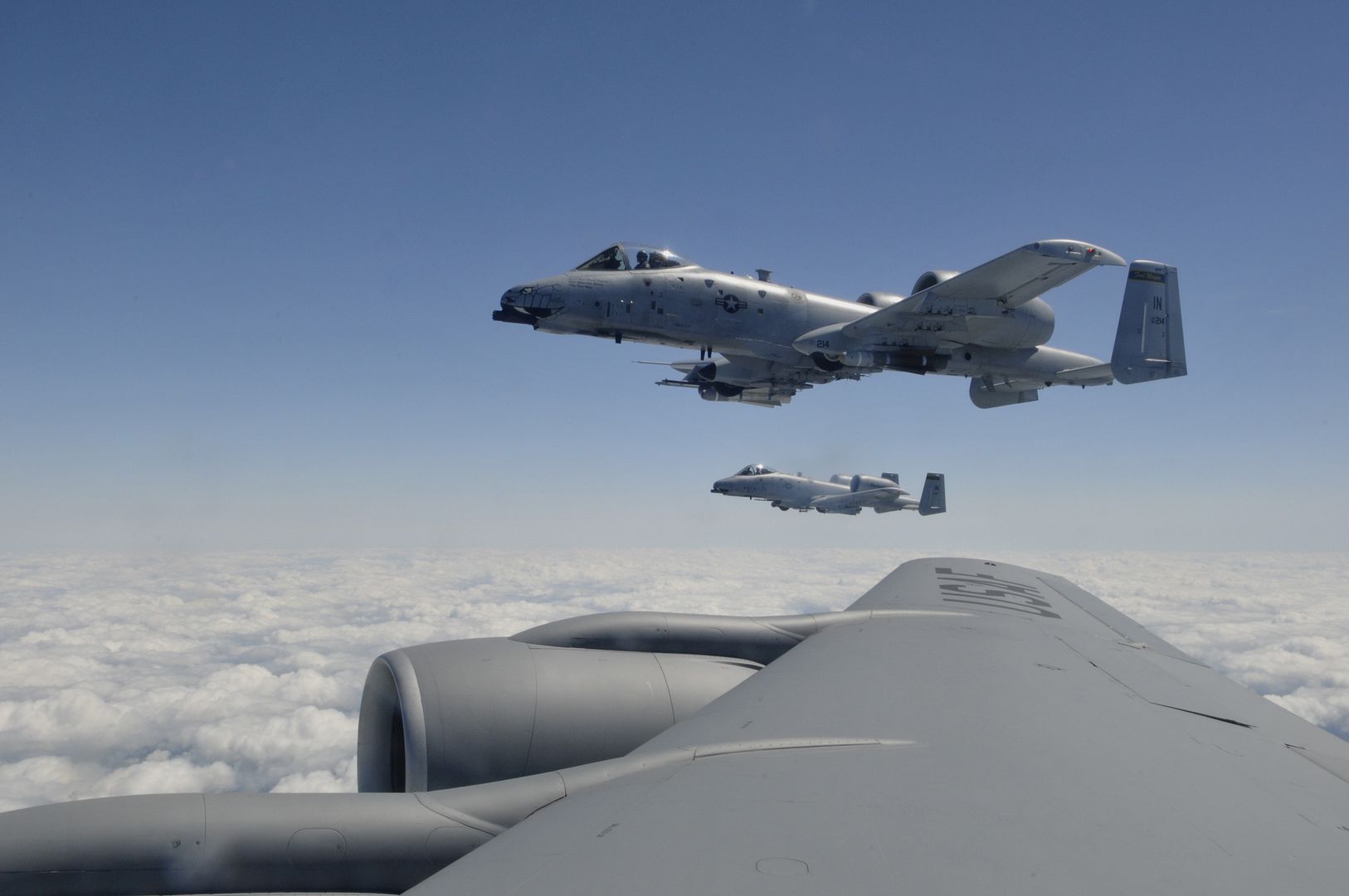
U.S. Marine Corps KC-130J Hercules aircraft with Marine Aerial Refueler Transport Squadrons (VMGR) 234 and 352, conduct division tactical navigation training with VMGR-152 as part of unit-level training Evergreen at Naval Air Station Whidbey Island, Washington, Aug. 18, 2017. Division tactical navigation training allows the squadrons? aircraft to perform gear drops in close proximity to a single location, which enhances operational efficiency. Evergreen will serve as VMGR-152?s 2017 Marine Corps Combat Readiness Evaluation through tri-lateral training with the U.S. Army 160th Special operations Aviation Regiment and U.S. Army 1st Special Forces Group to gain valuable insight on the most recent Operation Inherent Resolve assault-support tactics. (U.S. Marine Corps photo's by Cpl. Joseph Abrego)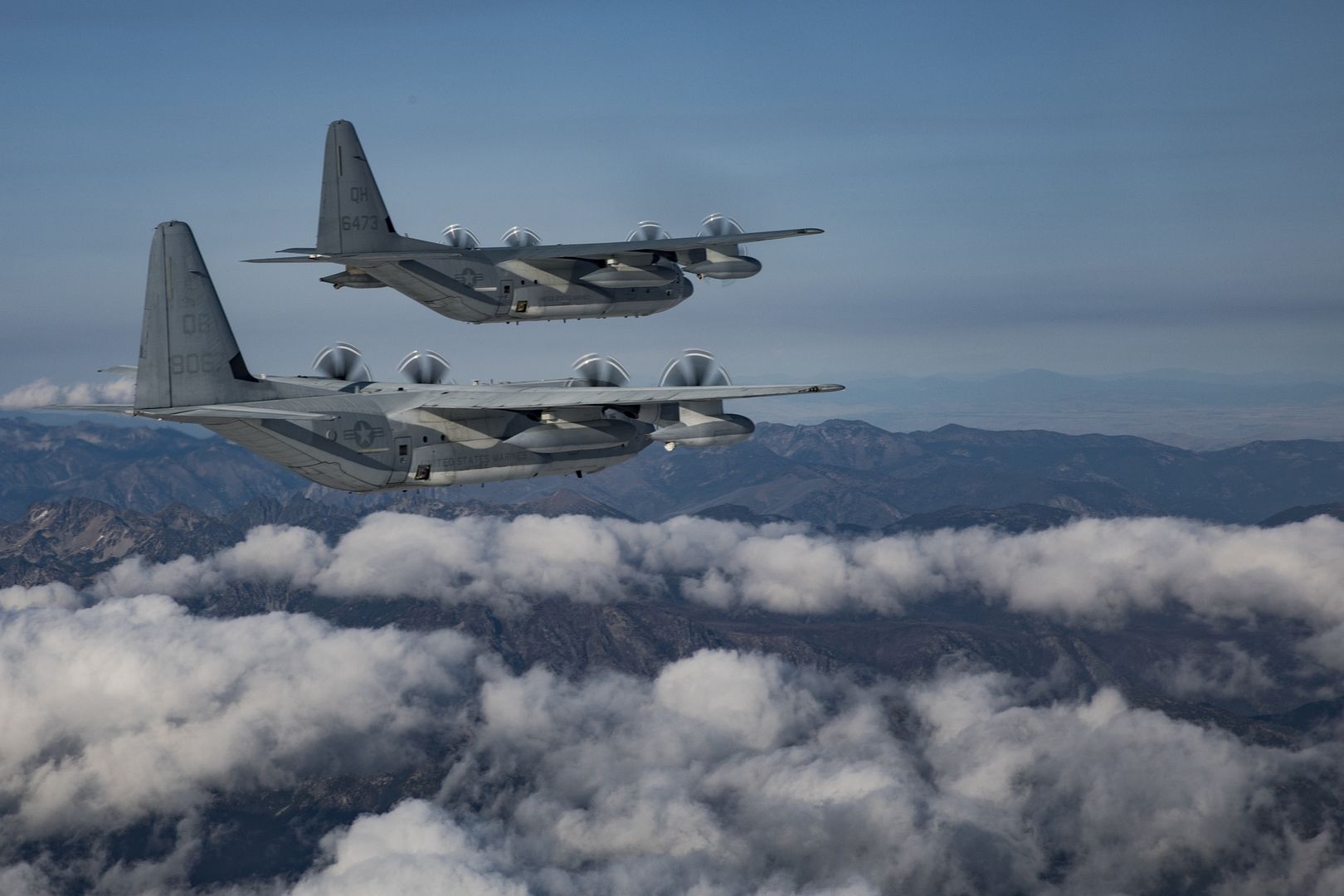
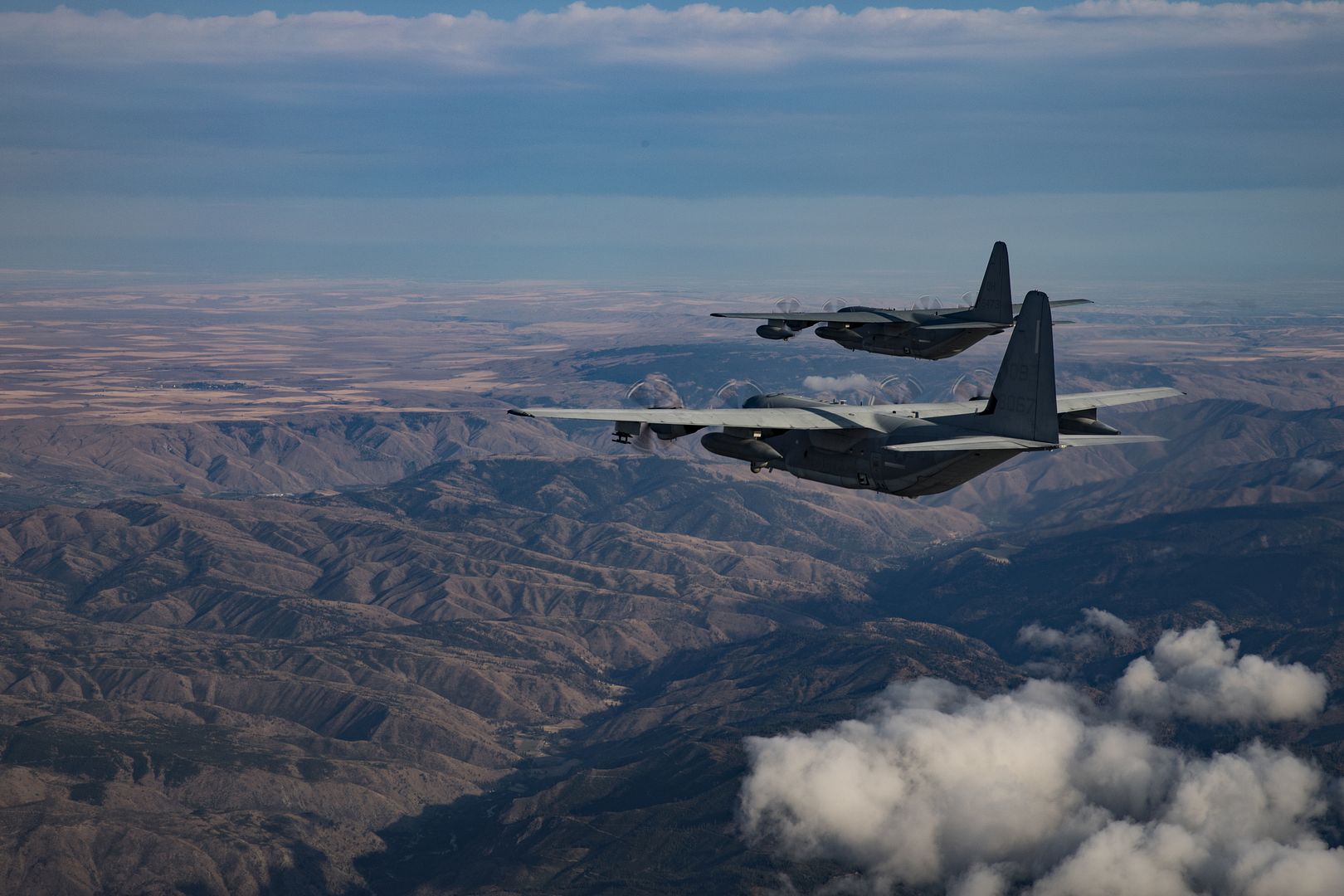
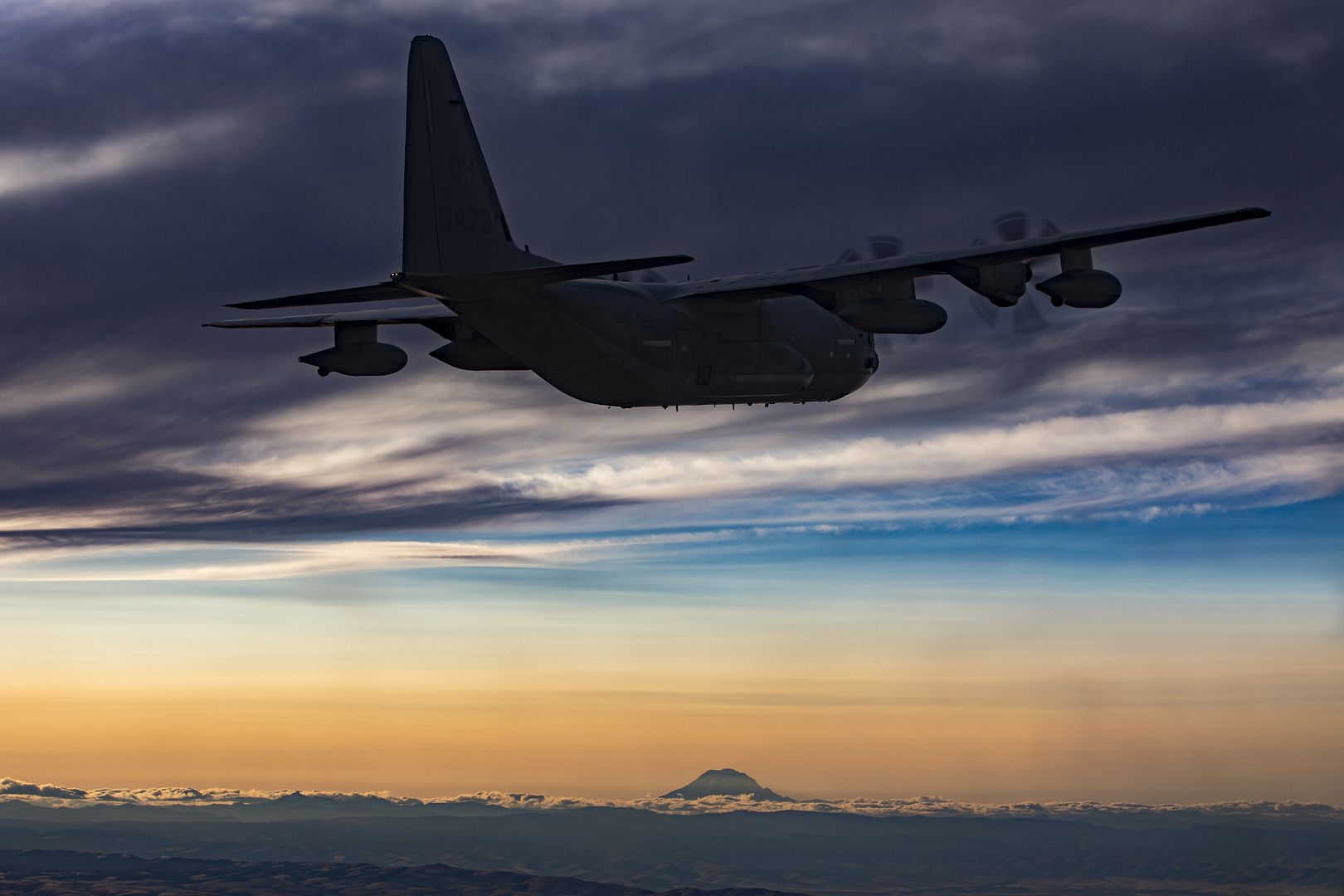
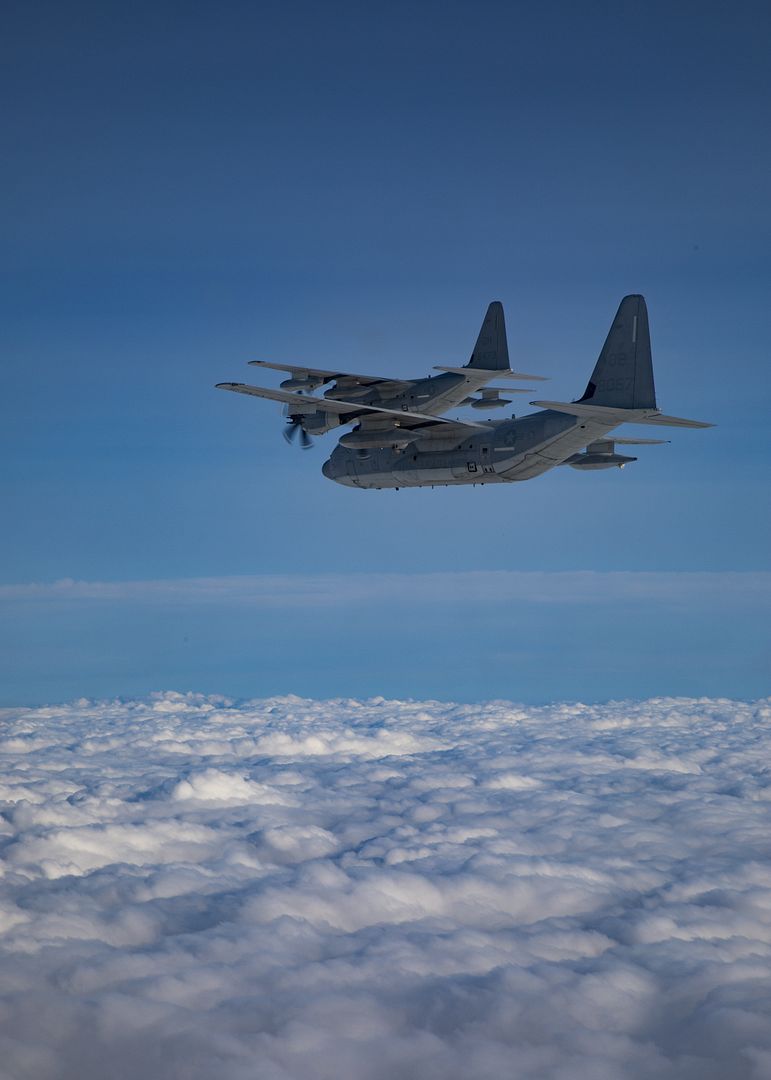
-
 Main AdminATLANTIC OCEAN (Aug. 20, 2017) An F/A-18E Super Hornet assigned to the "Tomcatters" of Strike Fighter Squadron (VFA) 31 breaks the sound barrier above the aircraft carrier USS George H.W. Bush (CVN 77) during an air power demonstration. The ship and its carrier strike group are returning home from a seven-month deployment in support of maritime security operations and theater security cooperation efforts in the U.S. 5th and 6th Fleet areas of responsibility. (U.S. Navy photo by Mass Communication Specialist 3rd Class Matt Matlage/Released)
Main AdminATLANTIC OCEAN (Aug. 20, 2017) An F/A-18E Super Hornet assigned to the "Tomcatters" of Strike Fighter Squadron (VFA) 31 breaks the sound barrier above the aircraft carrier USS George H.W. Bush (CVN 77) during an air power demonstration. The ship and its carrier strike group are returning home from a seven-month deployment in support of maritime security operations and theater security cooperation efforts in the U.S. 5th and 6th Fleet areas of responsibility. (U.S. Navy photo by Mass Communication Specialist 3rd Class Matt Matlage/Released)
KIRTLAND AIR FORCE BASE, N.M. -- The Air Force announced Aug. 21 the award of two Technology Maturation and Risk Reduction contracts for its Ground Based Strategic Deterrent intercontinental ballistic missile weapon system program. Contracts were awarded to Boeing Company, Huntsville, Alabama, and Northrop Grumman Systems Corporation, Redondo Beach, California.
The GBSD is the weapon system replacement for the aging LGM-30 Minuteman III ICBM.
?We are moving forward with modernization of the ground-based leg of the nuclear triad,? said Secretary of the Air Force Heather Wilson. ?Our missiles were built in the 1970s. Things just wear out, and it becomes more expensive to maintain them than to replace them. We need to cost-effectively modernize.?
The Minuteman III first became operational in the early 1970s. While certain components and subsystems have been upgraded over the years, most of the fundamental infrastructure in use today is the original equipment supporting more than 50 years of continuous operation.
"Airmen must always be ready in this no-fail mission," said Chief of Staff of the Air Force Gen. David Goldfein. "As others have stated, the only thing more expensive than deterrence is fighting a war. The Minuteman III is 45 years old. It is time to upgrade."
The aging Minuteman III system will continue to face increasingly significant operational and sustainment challenges until replaced.
?The Minuteman III is the enduring ground-based leg of our nuclear triad. However, it is an aging platform and requires major investments to maintain its reliability and effectiveness,? said Gen. Robin Rand, commander of Air Force Global Strike Command. ?GBSD is the most cost-effective ICBM replacement strategy, leveraging existing infrastructure while also implementing mature, modern technologies and more efficient operations, maintenance and security concepts.?
For the GBSD acquisition effort, the Air Force Nuclear Weapons Center is focused on developing and delivering an integrated GBSD weapon system, including launch and command-and-control segments. The weapon?s developers will pursue a modular systems architecture, which will encourage continued competition across the lifecycle of the program. Additionally, a modular system will make the GBSD weapon system responsive to the challenges posed by the pace of technological change and new threat environments.
?The new GBSD weapon system will meet the combatant commander?s current requirements, while having the adaptability to affordably address changing technology and emerging threats through 2075,? said Maj. Gen. Scott Jansson, AFNWC commander and the Air Force program executive officer for strategic systems.
Two contracts, valued at no more than $359 million each, were awarded after a full and open competition. The companies selected were determined to provide the best overall value to the warfighter and taxpayers based on the source selection?s evaluation factors. The period of performance for each TMRR contract is approximately 36 months.
?I am proud of the hard work, professionalism and dedication of the GBSD program office members. We would not have gotten here without them,? said Col. Heath Collins, GBSD program manager for AFNWC. ?Over the last year, we have executed a thorough and fair source selection while also putting in place the tools, infrastructure and analytic capability to execute the GBSD program. We are ready, excited and honored to begin working with our industry partners to develop and deliver an affordable, low-risk ICBM replacement, guaranteeing uninterrupted nuclear deterrence capabilities for the nation.?
The GBSD program office is part of AFNWC?s ICBM Systems Directorate at Hill AFB, Utah. The center is responsible for synchronizing all aspects of nuclear materiel management on behalf of Air Force Materiel Command in direct support of AFGSC.
Headquartered at Kirtland AFB, the center has about 1,100 personnel assigned to 17 locations worldwide, including at Hanscom AFB, Massachusetts; Hill AFB, Utah; Eglin AFB, Florida; Tinker AFB, Oklahoma; and at Ramstein Air Base, Germany.
Cathay Pacific Group has signed a Memorandum of Understanding (MOU) with Airbus for 32 A321neo single-aisle aircraft. The aircraft will be operated by Cathay Dragon, the regional carrier of the Group, on services linking its Hong Kong home base with destinations across Asia.
The new A321neo aircraft will replace and modernise Cathay Dragon?s current in-service fleet of 15 A320s and eight A321s, with the additional aircraft allowing the airline to capture growth opportunities in the region. The Cathay Dragon network currently covers 56 Asian destinations, including 28 in mainland China.
Cathay Pacific Chief Executive Officer and Cathay Dragon Chairman Rupert Hogg said: ?The Airbus fleet has been serving Cathay Dragon well over the decades. With the A321neo we expect to benefit from a very significant increase in operating efficiency, while increasing capacity in the Cathay Dragon network in order to expand our reach to more customers.?
He added: ?The intention to purchase these 32 environmentally-friendly aircraft will allow us to add new destinations to Cathay Dragon?s network, increase frequency on some of our most popular routes and expand our network in the region in order to provide more travel choices and convenience to our customers.?
John Leahy, Airbus Chief Operating Officer, Customers said: ?Airbus is proud to have been selected to supply Cathay Dragon?s future single-aisle fleet. This is another major endorsement of the A321neo as the aircraft of choice in the middle-of-the-market segment.?
?The A321neo offers the lowest operating costs, longest range capability and most spacious cabin in its class. It will be the perfect aircraft for Cathay Dragon as it builds on its success as one of Asia?s leading regional carriers.?
Cathay Dragon is an all Airbus operator, with a current fleet of 23 A320 Family aircraft and 24 widebody A330-300s. In addition, Cathay Pacific operates 37 A330-300s, making the Group the largest A330 operator in the Asia-Pacific region. Cathay Pacific also operates the all-new long haul A350 XWB, with 17 A350-900s already in service. The carrier has another 31 A350 XWBs on order for future delivery, including the A350-900 and larger A350-1000.
The A321 is the largest member of the A320 Family and seats up to 240 passengers, depending on cabin configuration. Incorporating the latest engines, aerodynamic advances and cabin innovations, the A321neo offers a reduction in fuel consumption of up to 20 per cent per seat and can fly up to 4,000 nautical miles (7,400 kilometres) non-stop ? further than any other single-aisle airliner.
The A320 Family is the world?s best-selling single-aisle product line and comprises four models (A318, A319, A320, A321) seating from 100 to 240 seats. To date, the Family has won over 13,200 orders and more than 7,700 aircraft have been delivered to some 400 customers and operators worldwide.
-
 Main AdminU.S. Air Force F-22 Raptors are at the ready for the night mission at Red Flag 17-4 at Nellis Air Force Base, Nev., Aug. 21, 2017. During the mission Capt. Flash, 94th Fighter Squadron pilot, will complete his mission commander upgrade certification. (U.S. Air Force photo by Staff Sgt. Carlin Leslie)
Main AdminU.S. Air Force F-22 Raptors are at the ready for the night mission at Red Flag 17-4 at Nellis Air Force Base, Nev., Aug. 21, 2017. During the mission Capt. Flash, 94th Fighter Squadron pilot, will complete his mission commander upgrade certification. (U.S. Air Force photo by Staff Sgt. Carlin Leslie)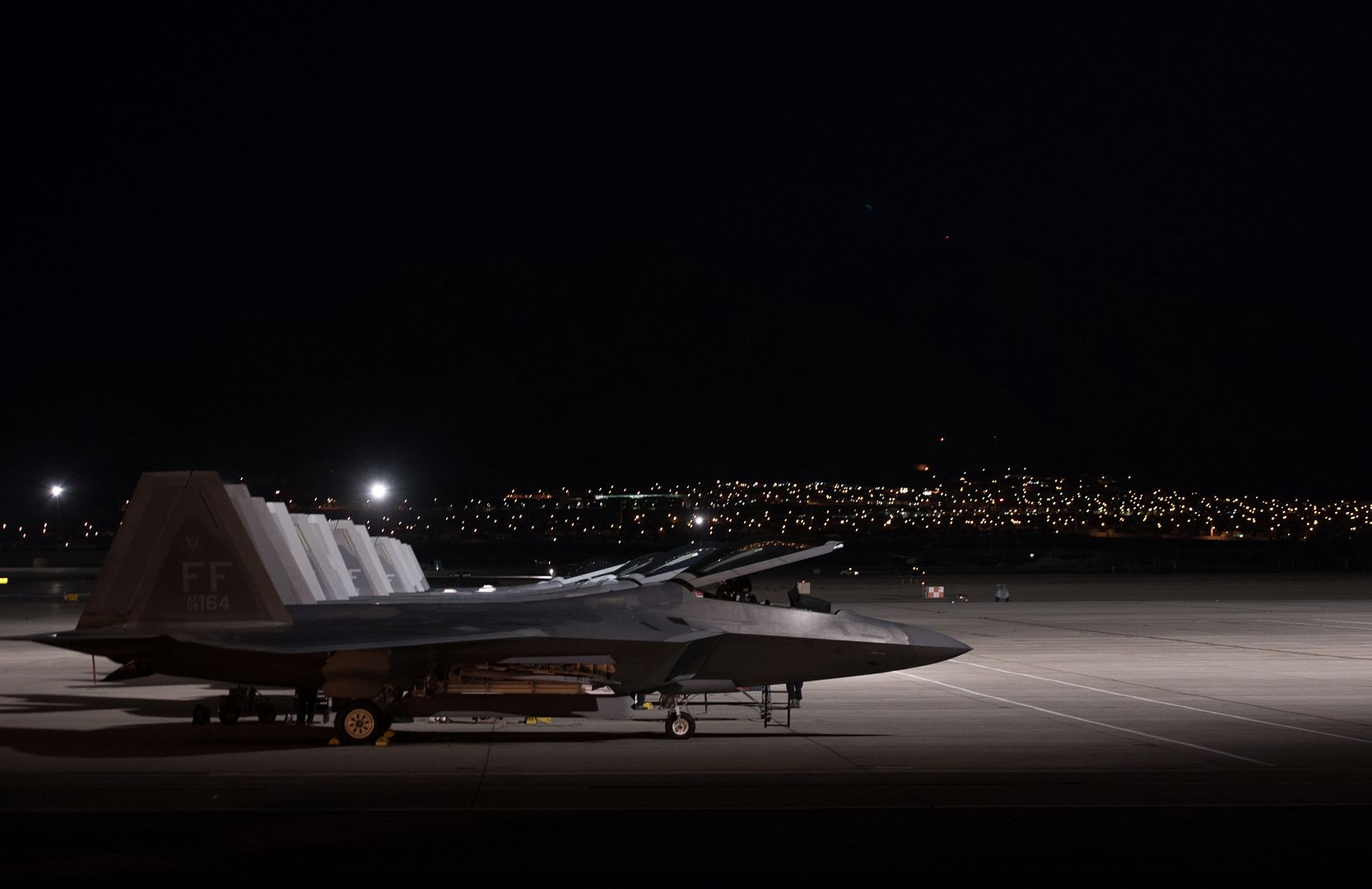
Air Force One taxied on to the Marine Corps Air Station (MCAS) Yuma, Ariz., flightline Aug. 22, 2017. President Trump visited MCAS Yuma to interact with Marines and their families on station. (U.S. Marine Corps photo by Lance Cpl. Joel Soriano)
PACIFIC OCEAN (Aug. 21, 2017) An F/A-18F Super Hornet assigned to the "Stingers" of Strike Fighter Attack Squadron (VFA) 113 prepares to land on the flight deck of the aircraft carrier USS Theodore Roosevelt (CVN 71). Theodore Roosevelt is underway conducting a composite training unit exercise (COMPTUEX) with the Theodore Roosevelt Carrier Strike Group in preparation for an upcoming deployment. COMPTUEX tests a carrier strike group?s mission readiness and ability to perform as an integrated unit through simulated real-world scenarios. (U.S. Navy photo by Mass Communication Specialist 3rd Class Austin R. Clayton/Released)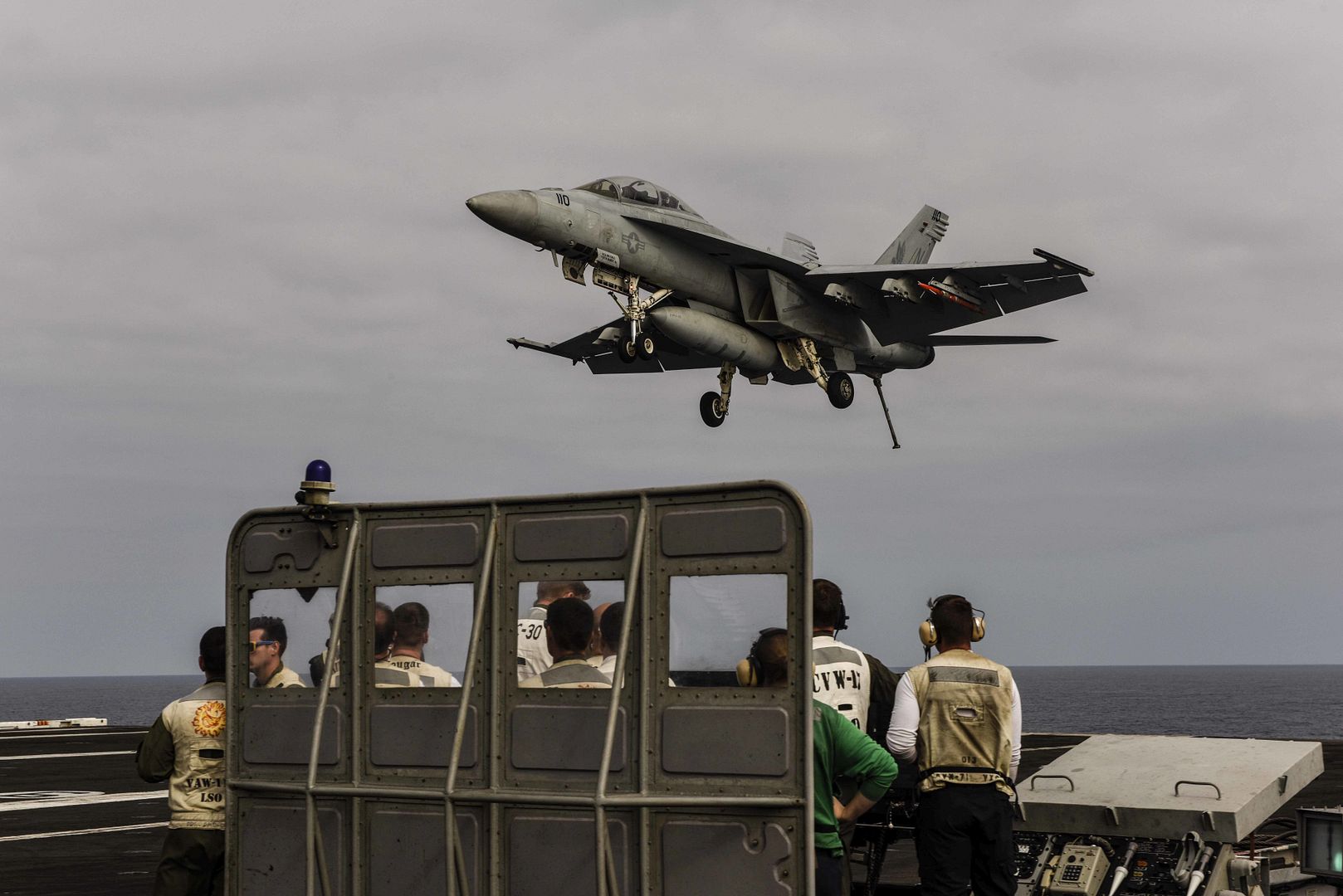
ATLANTIC OCEAN (Aug. 21, 2017) An F/A-18F Super Hornet assigned to the ?Red Rippers? of Strike Fighter Squadron (VFA) 11 lands on the flight deck of the aircraft carrier USS Harry S. Truman (CVN 75). Harry S. Truman is underway conducting flight deck certifications in preparation for future operations. (U.S. Navy photo by Mass Communication Specialist Seaman Rebekah A. Watkins/Released)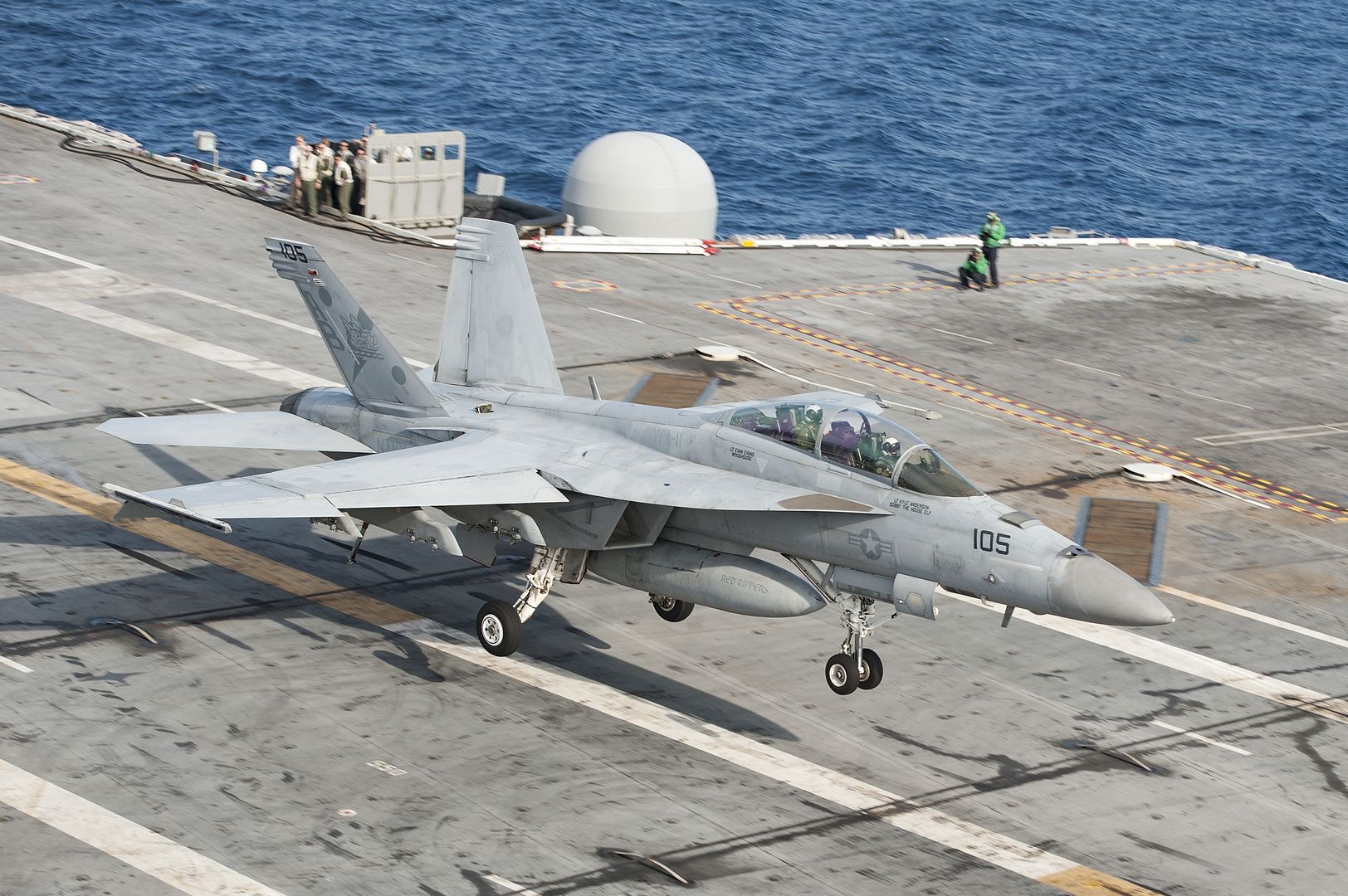
An F-16 Fighting Falcon, belonging to the 555th Expeditionary Fighter Squadron, sits on the ramp at Bagram Airfield, Afghanistan, Aug. 22, 2017. The 555th EFS, deployed out of Aviano Air Base, Italy, conducts counterterrorism operations which enable Resolute Support?s train, advise, and assist campaign. (U.S. Air Force photo by Staff Sgt. Benjamin Gonsier)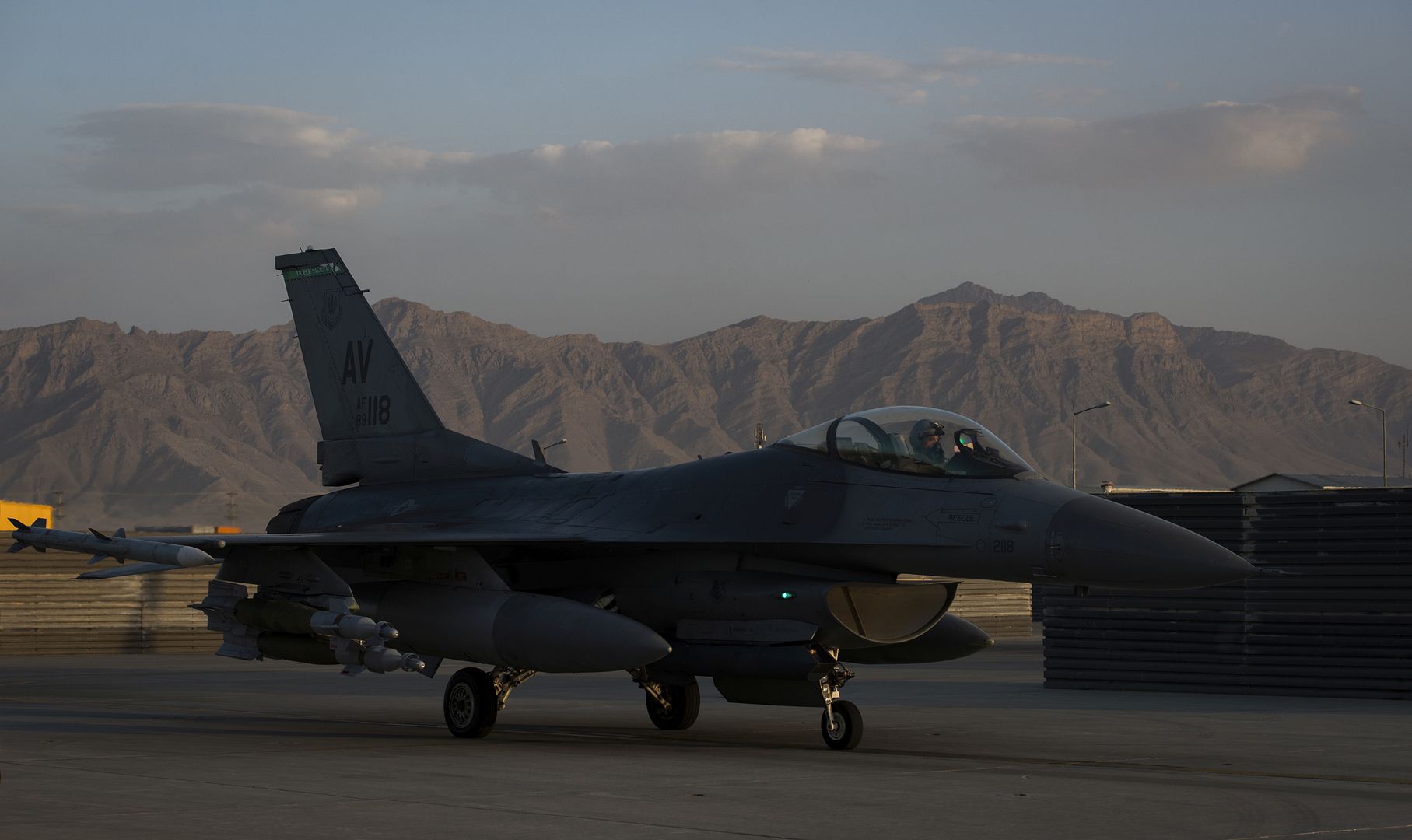
-
 Main AdminA U.S. Air Force Aerial Demonstration Squadron "Thunderbird" F-16 sits on the flight line at sunrise on Atlantic City Air National Guard Base, N.J., Aug. 23, 2017. The Thunderbirds are in town for the Thunder Over the Boardwalk Air Show which takes place over the beaches of Atlantic City, N.J., Aug. 22-23. (U.S. Air National Guard photo's by Master Sgt. Matt Hecht/Released)
Main AdminA U.S. Air Force Aerial Demonstration Squadron "Thunderbird" F-16 sits on the flight line at sunrise on Atlantic City Air National Guard Base, N.J., Aug. 23, 2017. The Thunderbirds are in town for the Thunder Over the Boardwalk Air Show which takes place over the beaches of Atlantic City, N.J., Aug. 22-23. (U.S. Air National Guard photo's by Master Sgt. Matt Hecht/Released)
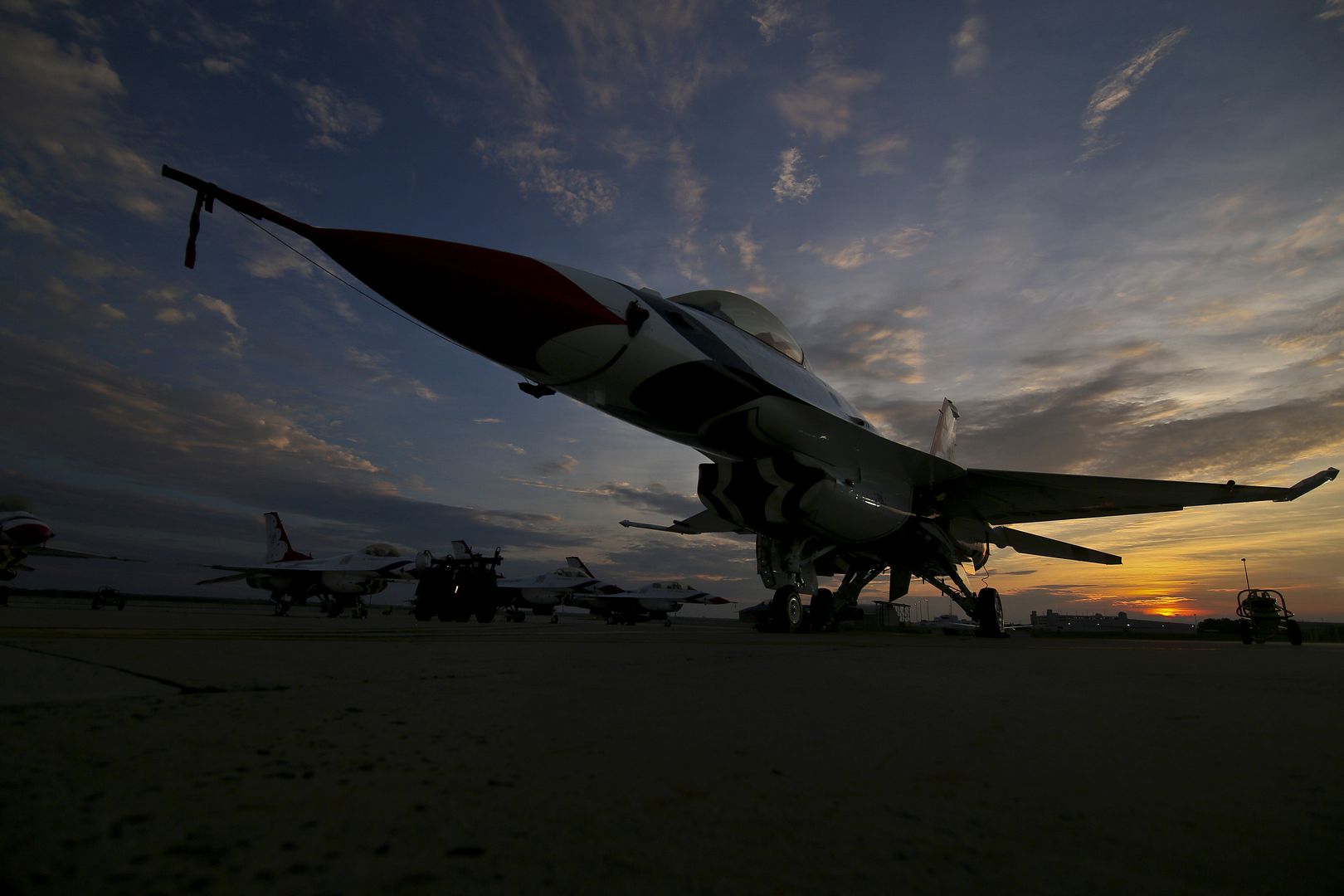
A U.S. Air Force KC-135R Stratotanker from the New Jersey Air National Guard's 108th Wing flies over Atlantic City, N.J., during the Thunder Over the Boardwalk Air Show, Aug. 23, 2017. (U.S. Air National Guard photo by Master Sgt. Matt Hecht/Released)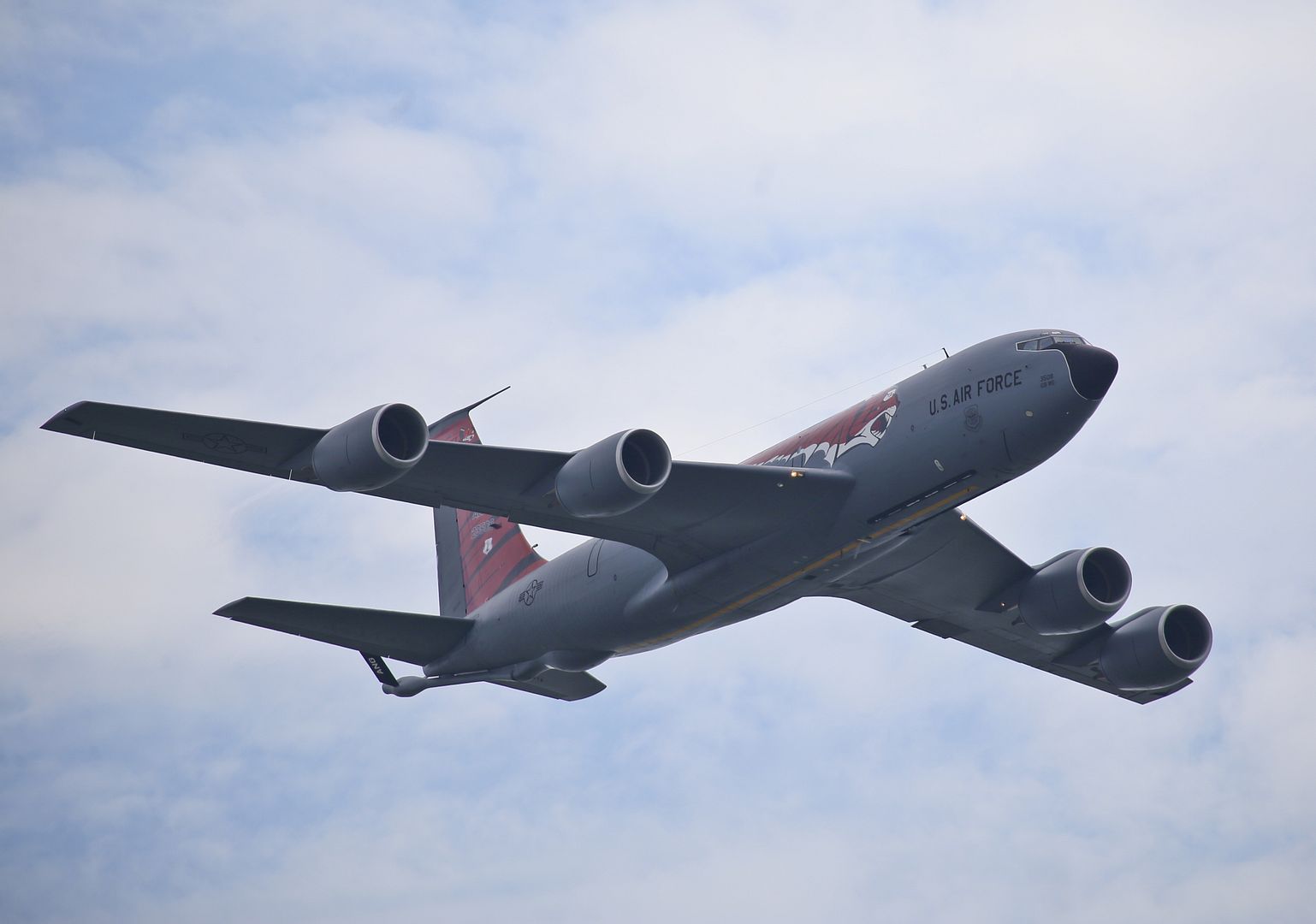
PACIFIC OCEAN (Aug. 19, 2017) An F-35B Lightning II Joint Strike Fighter assigned to the "Avengers" of Marine Fighter Attack Squadron (VMFA) 211 prepares to land on the flight deck of the Wasp-class amphibious assault ship USS Essex (LHD 2). Essex is underway conducting sea trials and flight deck certifications off the coast of Southern California. (U.S. Navy photo by Mass Communication Specialist 2nd Class Irwin Sampaga/Released)
PACIFIC OCEAN (Aug. 22, 2017) A C-2A Greyhound assigned to the Providers of Fleet Logistics Support Squadron (VRC) 30, prepares to land on the flight deck aboard the aircraft carrier USS Theodore Roosevelt (CVN 71). Theodore Roosevelt is underway conducting a composite training unit exercise (COMPTUEX) with the Theodore Roosevelt Carrier Strike Group in preparation for an upcoming deployment. COMPTUEX tests a carrier strike group?s mission-readiness and ability to perform as an integrated unit through simulated real-world scenarios. (U.S. Navy photo by Mass Communication Specialist 3rd Class Alex Corona/Released)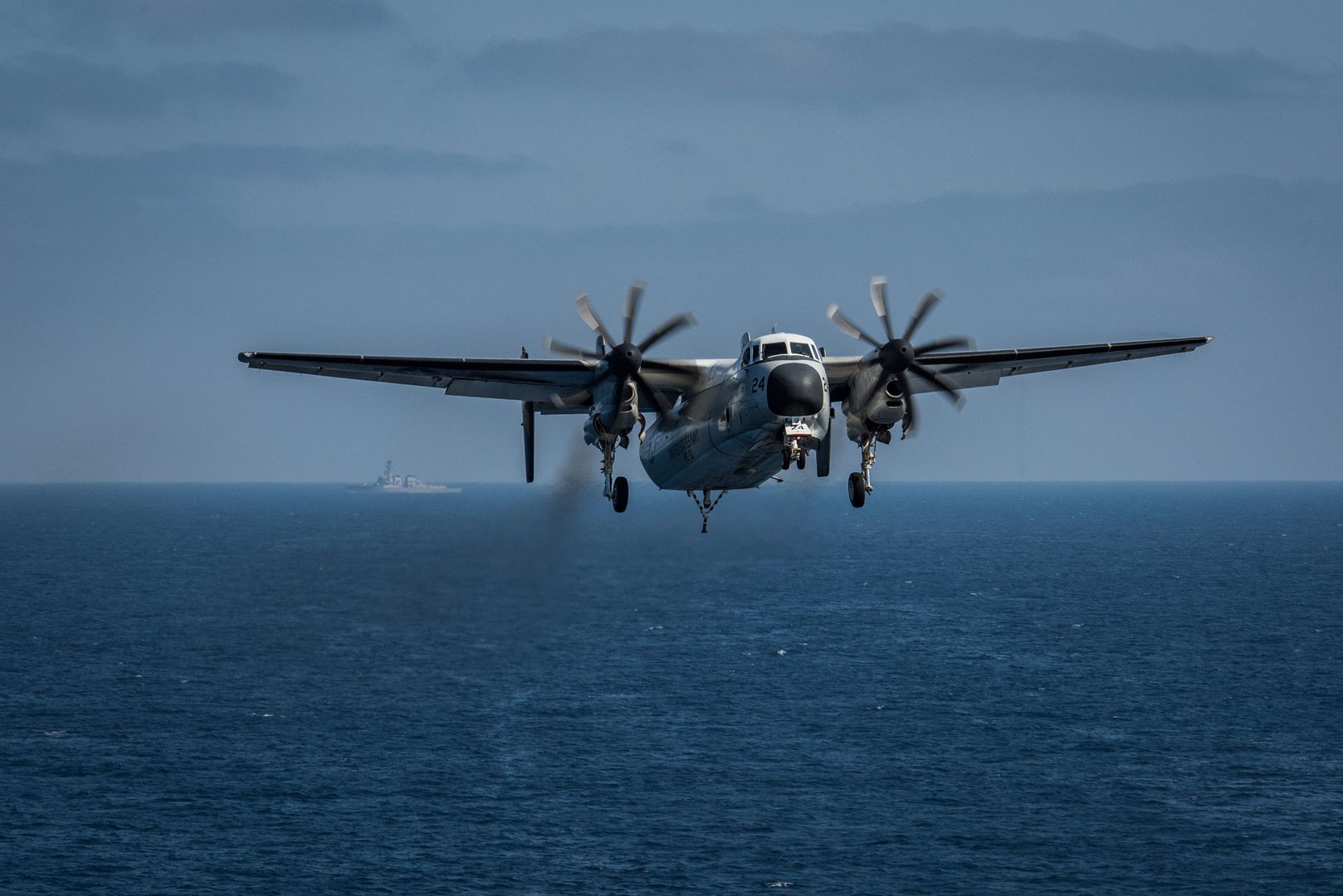
TEL AVIV, Israel, Aug. 23, 2017 /PRNewswire/ -- Boeing [NYSE: BA], EL AL Israel Airlines and Air Lease Corporation are celebrating the delivery of the carrier's first Boeing 787 Dreamliner today.
EL AL leased the airplane through an agreement with Air Lease Corporation.
The 787-9 touched down in Tel Aviv today following a nonstop, 6,746 mile (10,856 km.) delivery flight from Paine Field, adjacent to Boeing's factory in Everett, Wash.
"The arrival of the first Boeing 787 Dreamliner is a day of pride and joy to all of us at EL AL," said EL AL Chief Executive Officer David Maimon. "It is the highlight in the ongoing renewal of the EL AL fleet, which started a year and a half ago when we decided to order 16 Boeing 787 Dreamliners. We are happy to embark on a new journey with our first Dreamliner."
"The arrival of the new airplanes will create a revolution in the customer experience. We have set a very high standard of service and product excellence in order to maintain our position as the first and preferred choice for passengers, travelling both to and from Israel," said Maimon. "I am convinced that this significant procurement of 787s is a great opportunity for us to meet the highest levels expected. The Dreamliner will ensure our customers receive exceptional comfort, innovative technology, advanced aircraft and quality service."
The 787 is a family of technologically advanced, super-efficient airplanes with new passenger-pleasing features. In addition to bringing big-jet ranges to midsize airplanes, the 787 will provide EL AL with unmatched fuel efficiency and environmental performance, using 20 to 25 percent less fuel and with 20 to 25 percent fewer emissions than the airplanes it replaces.
"We are honored to deliver the first 787 Dreamliner to our great partners at EL AL," said Ray Conner, vice chairman, The Boeing Company. "The 787 Dreamliner will play a key role in the renewal of EL AL's fleet and growing its network worldwide as it ushers in a new era for the airline, its employees and its customers around the globe."
EL AL has been an all-Boeing carrier since taking delivery of its first new Boeing airplane in 1961 and currently operates a fleet of more than 40 airplanes including Next-Generation 737s, 747s, 767s and 777s.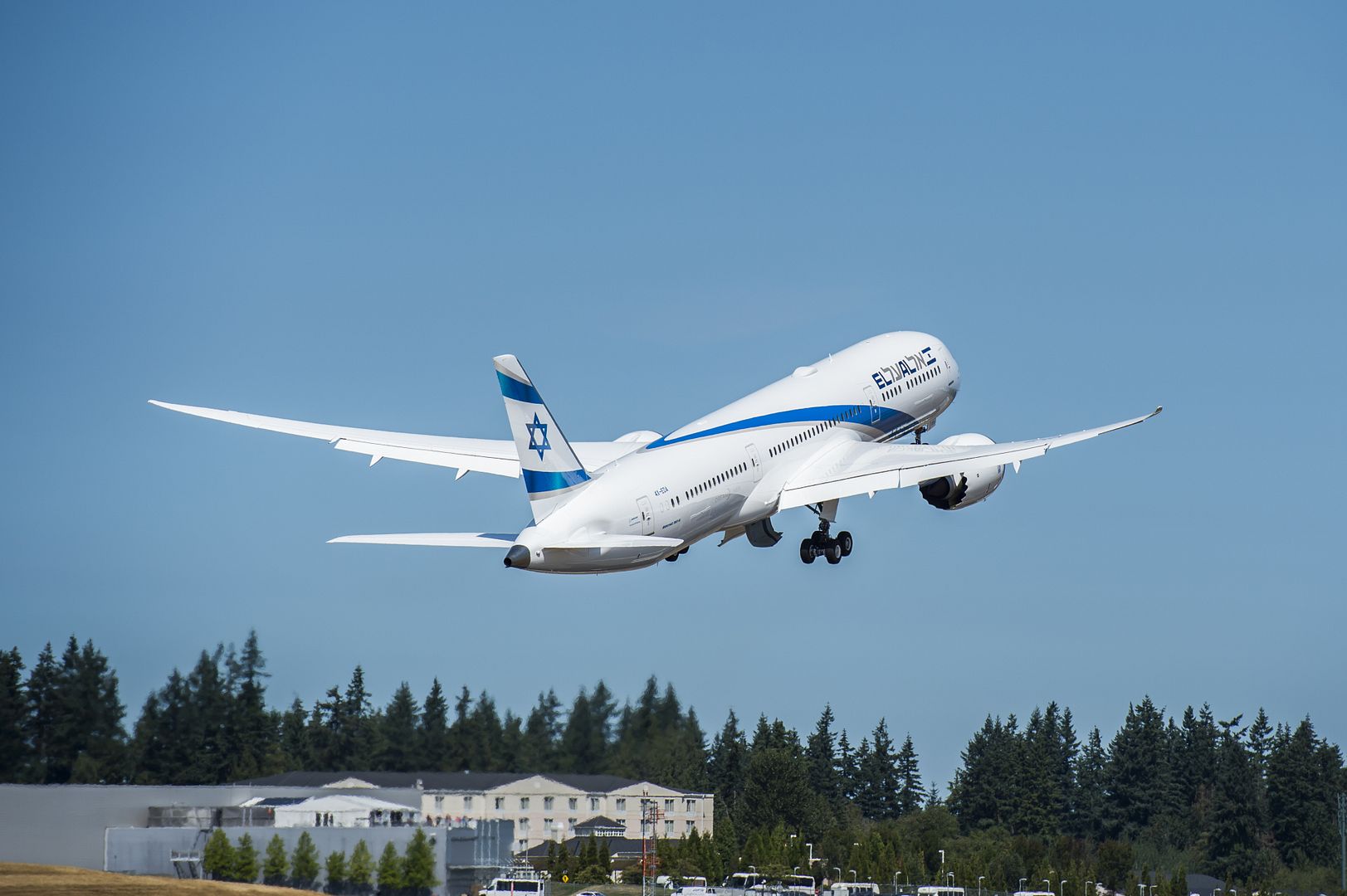
-
 Main AdminARABIAN GULF (Aug. 23, 2017) An F/A-18C Hornet assigned to the ?Death Rattlers? of Marine Strike Fighter Squadron (VMFA) 323 prepares to take off from the aircraft carrier USS Nimitz (CVN 68). Nimitz is deployed to the U.S. 5th Fleet area of operations in support of Operation Inherent Resolve. While in the region, the ship and its carrier strike group are conducting maritime security operations to reassure allies and partners, preserve freedom of navigation and maintain the free flow of commerce. (U.S. Navy photo by Mass Communication Specialist 2nd Class Elesia K. Patten/Released)
Main AdminARABIAN GULF (Aug. 23, 2017) An F/A-18C Hornet assigned to the ?Death Rattlers? of Marine Strike Fighter Squadron (VMFA) 323 prepares to take off from the aircraft carrier USS Nimitz (CVN 68). Nimitz is deployed to the U.S. 5th Fleet area of operations in support of Operation Inherent Resolve. While in the region, the ship and its carrier strike group are conducting maritime security operations to reassure allies and partners, preserve freedom of navigation and maintain the free flow of commerce. (U.S. Navy photo by Mass Communication Specialist 2nd Class Elesia K. Patten/Released)
ATLANTIC OCEAN (Aug. 23, 2017) An E-2D Hawkeye early warning and attack aircraft assigned to the ?Seahawks? of Carrier Airborne Early Warning Squadron (VAW) 126 prepares to land on the flight deck of the aircraft carrier USS Harry S. Truman (CVN 75). Harry S. Truman is underway conducting flight deck certifications in preparation for future operations. (U.S. Navy photo by Mass Communication Specialist Rebekah A. Watkins/Released)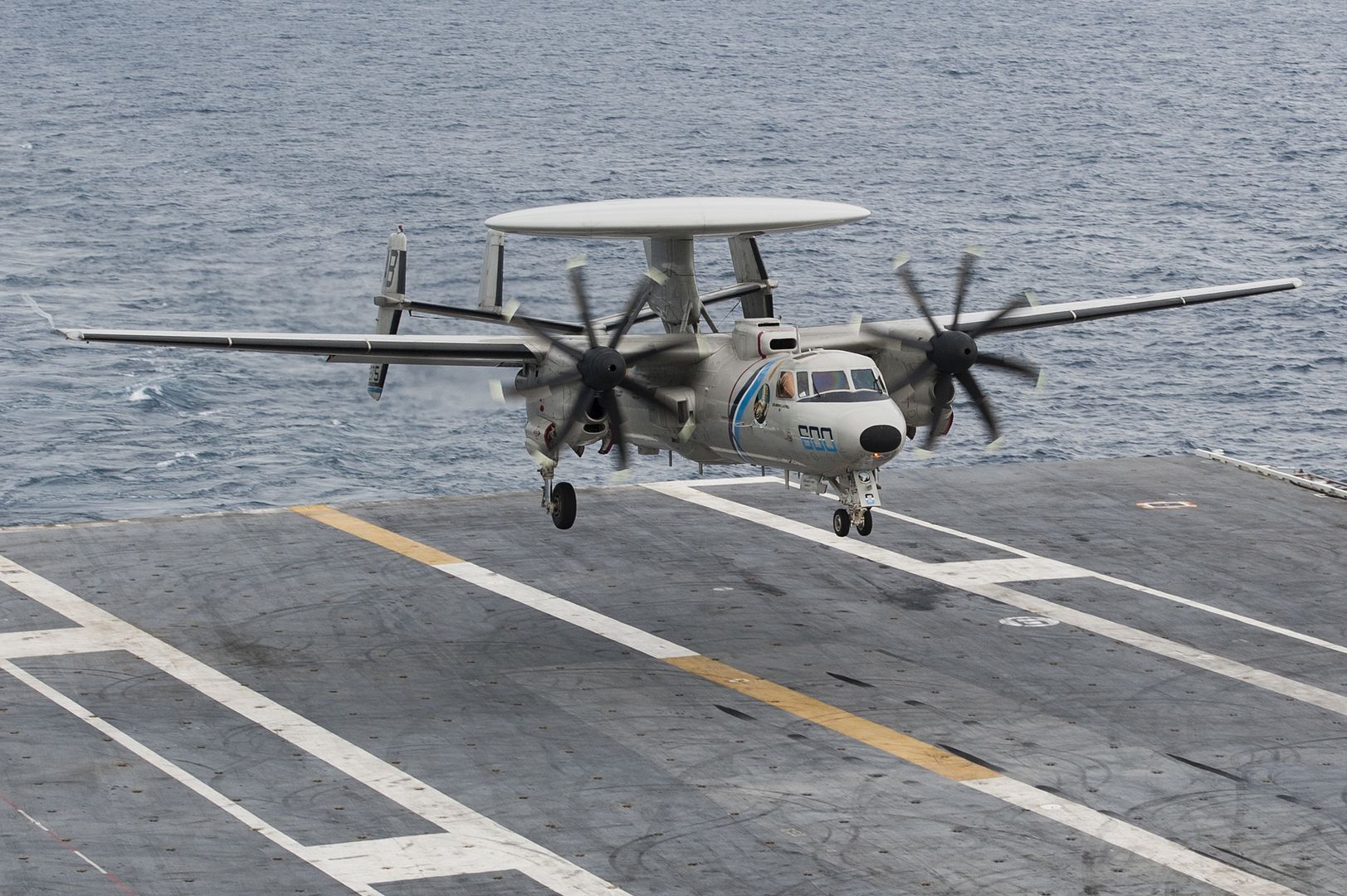
Bucharest, Romania, 24 August 2017 ? Airbus Helicopters and IAR, Romania?s leading aerospace company, have decided to extend their exclusive cooperation on the H215M multirole helicopter. Under this general agreement IAR will become the prime contractor for the H215M for any future order by the Romanian Ministry of Defense to replace their ageing fleet. Initially signed for 5 years, the agreement has been extended to 15 years, further underlining the commitment of Airbus Helicopters and IAR to jointly contribute to the modernization of the Romanian armed forces fleet of multirole helicopters in the long term.
The announcement took place during French President Emmanuel Macron?s official visit to Bucharest and in presence of Romanian President Klaus Iohannis.
?We are proud to have extended this agreement as a result of a long term trust between IAR and Airbus Helicopters? said Neculai Banea, General Director of IAR. ?IAR has built over 360 helicopters under Airbus Helicopters? license over the past decades, which makes us confident in the future success of the H215M? he added.
Under this agreement, IAR will act as prime contractor for all future H215M orders that could be placed by the Romanian Ministry of Defense. It also covers cooperation between Airbus Helicopters and IAR on the production, assembly, customization, support and maintenance of the H215M helicopters destined to the Romanian Armed Forces, and export if opportunities arise.
?This 15-year agreement puts IAR and Airbus Helicopters in the best position to meet the future needs of the Romanian Armed Forces as they look at renewing their fleets of medium and heavy multirole helicopters? said Olivier Michalon, Airbus Helicopters Senior Vice President, Head of Europe region. ?Our goal of delivering superior value for our Romanian customers by offering the most complete line of products and services underlines Airbus? unfaltering commitment to Romania. Each major Airbus business unit contributes directly to the strengthening of the European defence industrial base. Today Airbus already accounts for over 5,000 direct and indirect jobs in Romania, through its divisions, Helicopters and Defence and Space, Commercial Airplanes with Premium Aerotec, as well as industrial partners like Aerostar, Turbomecanica, Aeroteh, Aerofina, etc., making the company the largest aerospace investor in the country,? he added.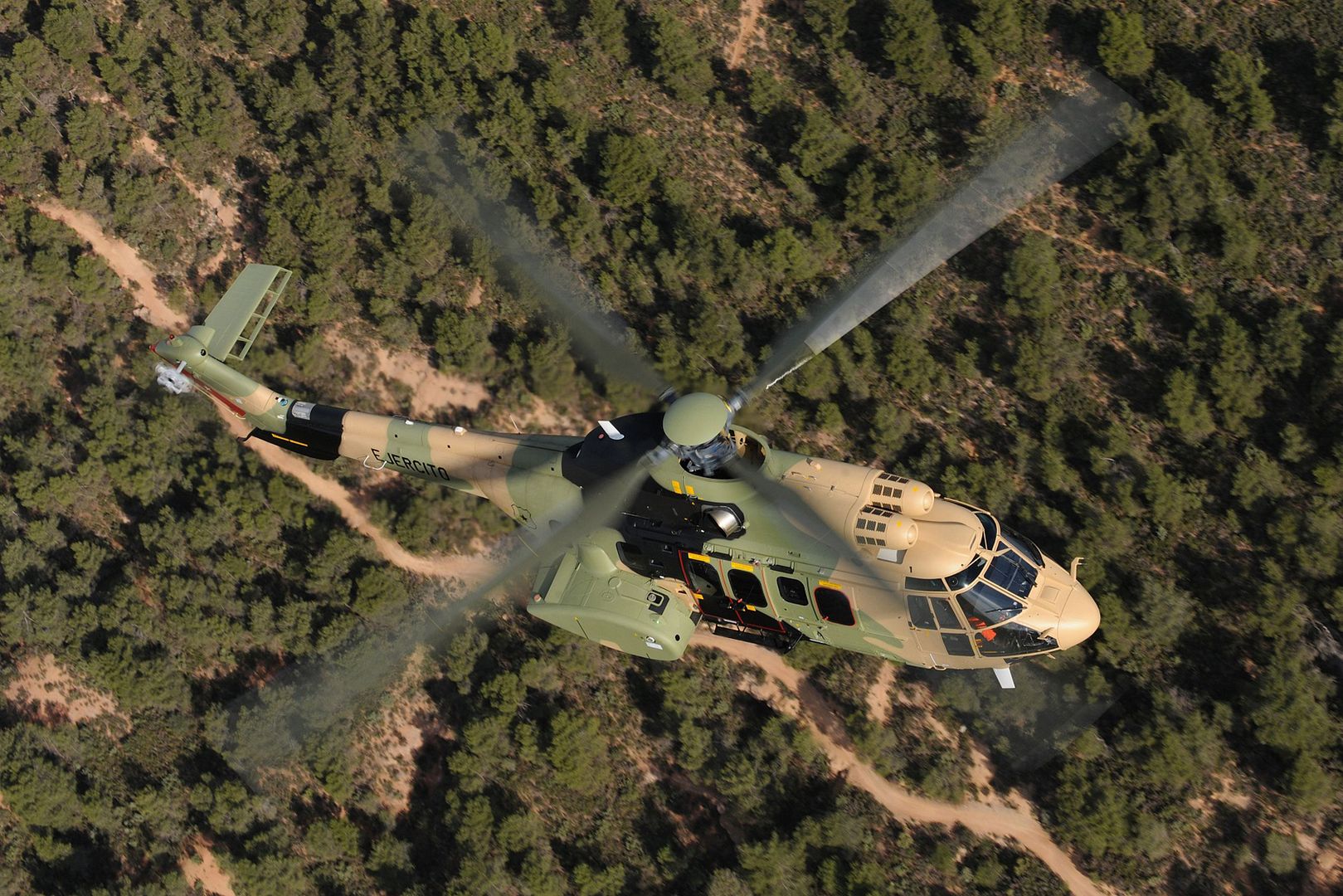
-
 Main AdminAn A-10 Warthog, 104th Fighter Squadron, Maryland Air National Guard, prepares to take-off from Keflavik Air Base, Iceland, Aug. 23, 2017. The A-10s were deployed to Estonia as part of a flying training deployment funded by the European Reassurance Initiative in support of Operation Atlantic Resolve. (U.S. Air Force photo by Tech. Sgt. Staci Miller)
Main AdminAn A-10 Warthog, 104th Fighter Squadron, Maryland Air National Guard, prepares to take-off from Keflavik Air Base, Iceland, Aug. 23, 2017. The A-10s were deployed to Estonia as part of a flying training deployment funded by the European Reassurance Initiative in support of Operation Atlantic Resolve. (U.S. Air Force photo by Tech. Sgt. Staci Miller)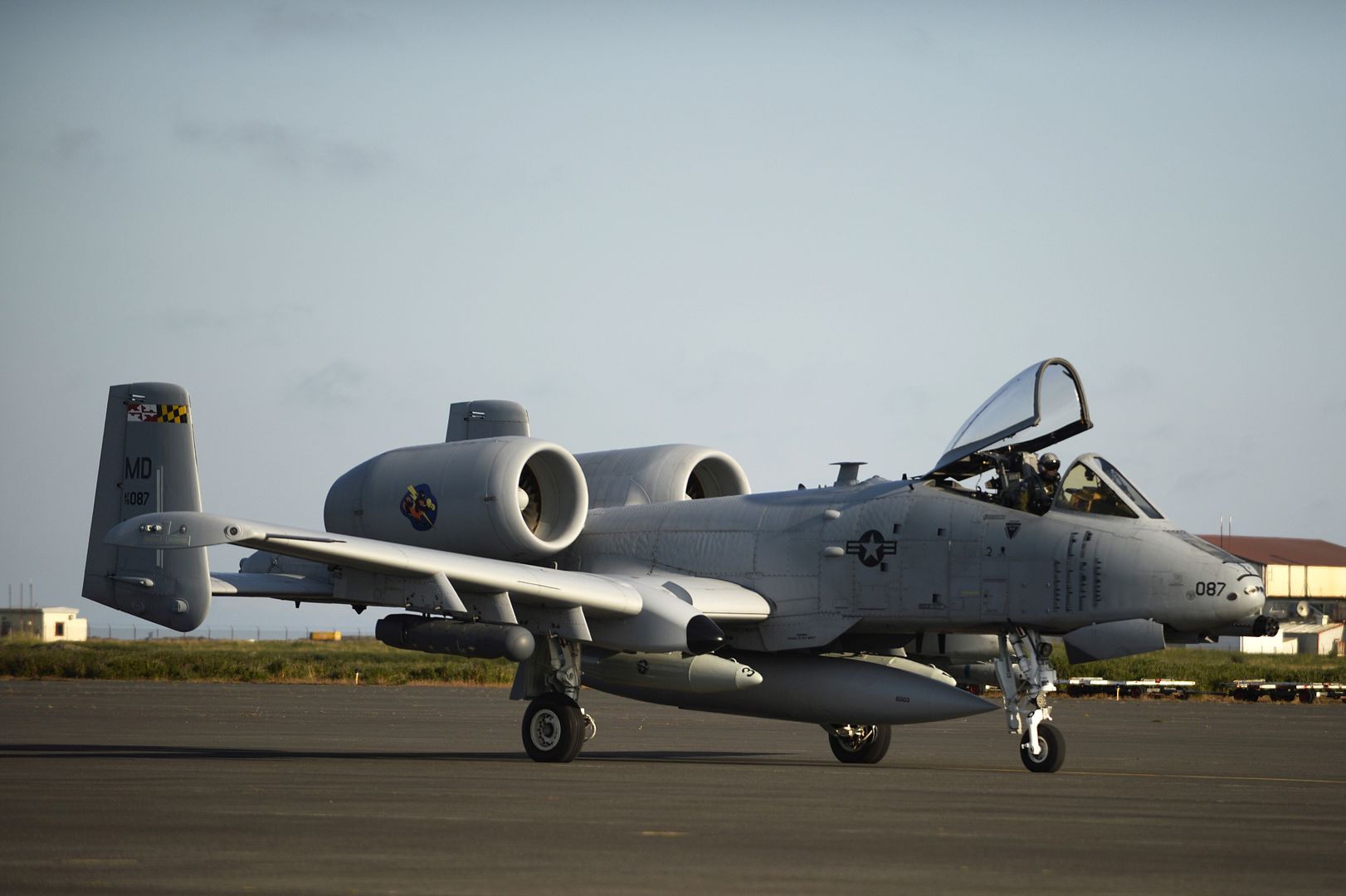
T-1A Jayhawk training aircraft from the 99th Flying Training Squadron, 12th Flying Training Wing, Randolph Air Force Base, Texas, are lined-up at Tinker AFB in Oklahoma City, Oklahoma Aug. 25, 2017, after relocating here to escape the path of Hurricane Harvey. Tinker has a memorandum of understanding with Randolph to accept aircraft that must be moved during hurricane evacuations. T-1As are primary jet trainer aircraft for pilots who will fly large/transport category aircraft. (U.S. Air Force photo/Greg L. Davis)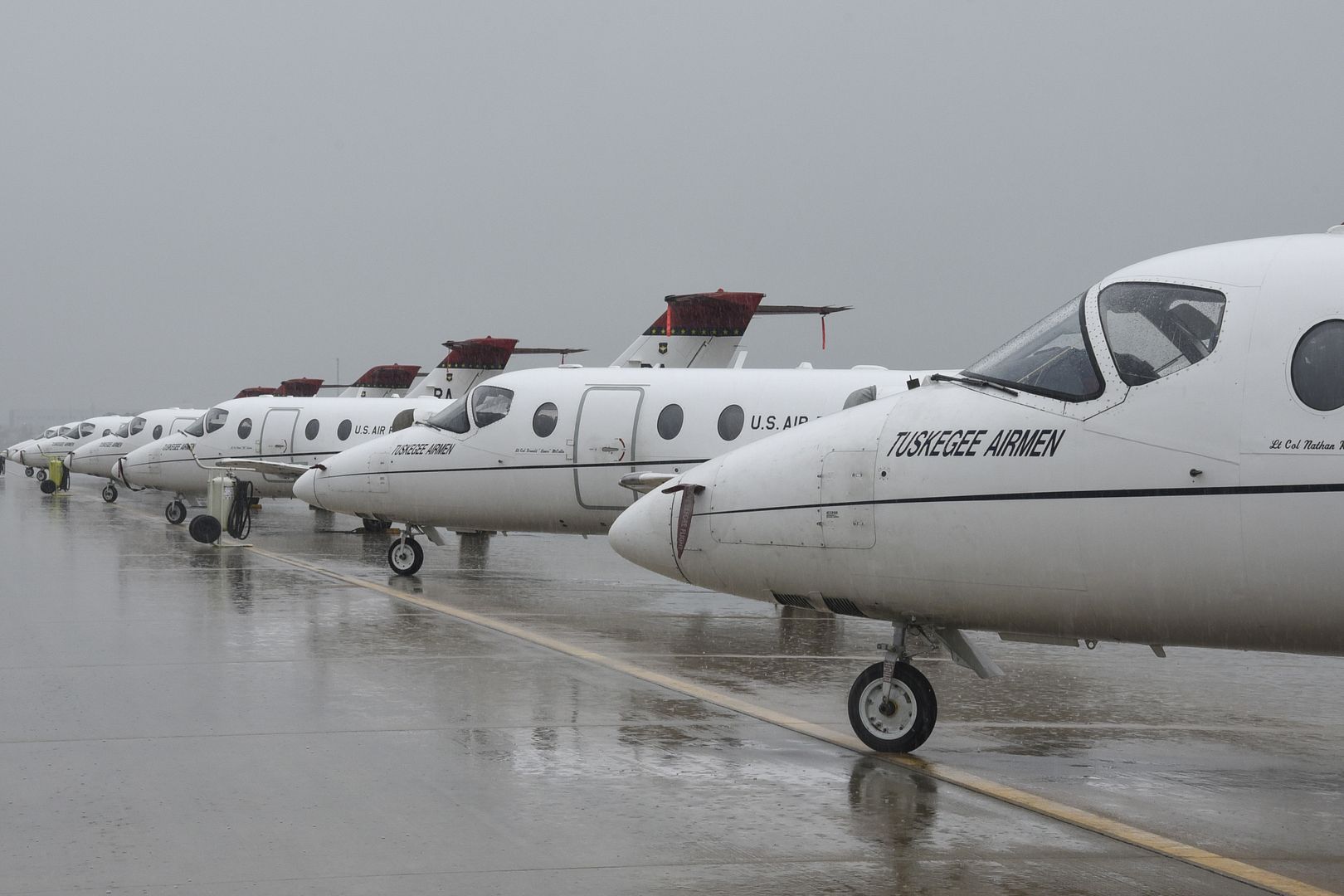
An MC-130J Commando II prepares to take off from Cannon Air Force Base, New Mexico, for training operations Aug. 23, 2017. This aircraft has been in use at Cannon AFB since September 2011. (U.S. Air Force photo by Staff Sgt. Charles Dickens/Released)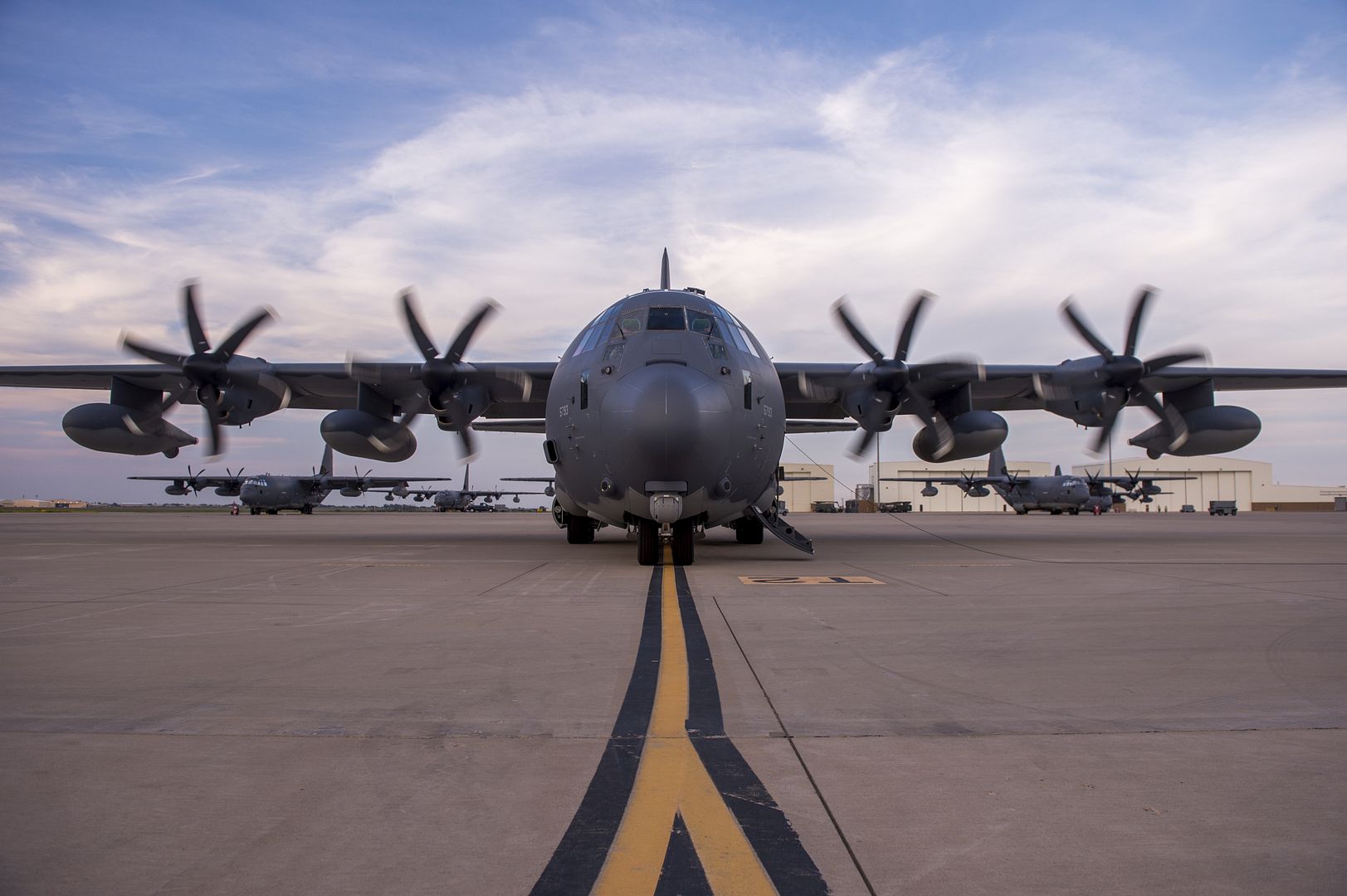
Pilots with the Iowa Air National Guard?s 185th Air Refueling Wing?s fly the unit?s first KC-135 aircraft converted with the newest digital avionics cockpit instruments, known as the Block 45 modification, back to Sioux City, Iowa on August 25, 2017. The new instrument panel replaces the radio altimeter, auto-pilot, digital flight director on the center column of the cockpit.
U.S. Air National Guard Photo's by Master Sgt. Vincent De Groot 185th ARW PA/Released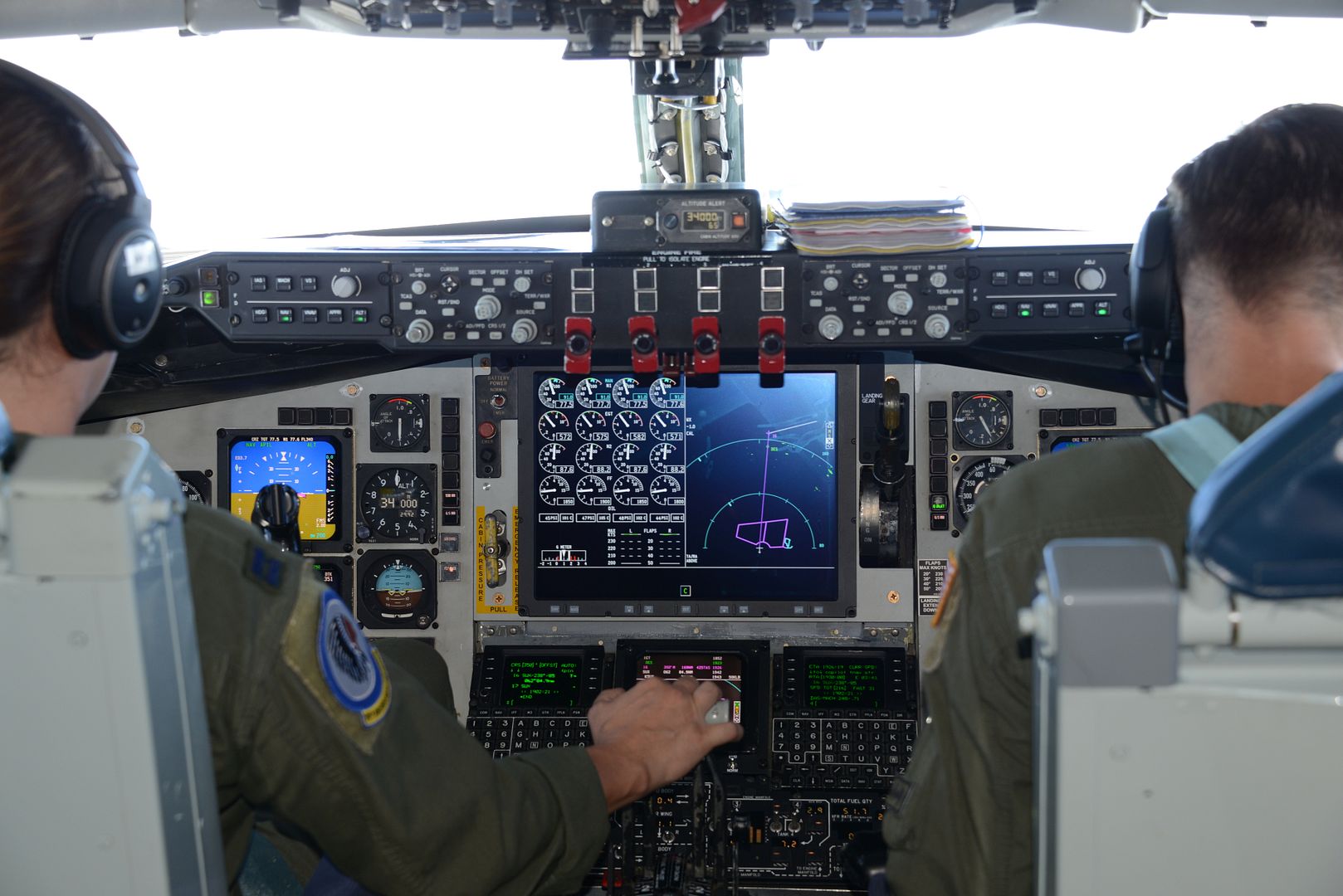

The U.S.A.F. Thunderbirds? F-16 Fighting Falcons line the flightline of Dover Air Force Base, Del., Aug. 25, 2017, for the Thunder Over Dover Open House Family Day. The Thunderbirds are the Air Force?s premier aerial demonstration team, led by Lt. Col. Jason Heard, commander/leader of the U.S. Air Force Air Demonstration Squadron and pilot of the No. 1 jet. (U. S. Air Force photo by Staff Sgt. Aaron J. Jenne)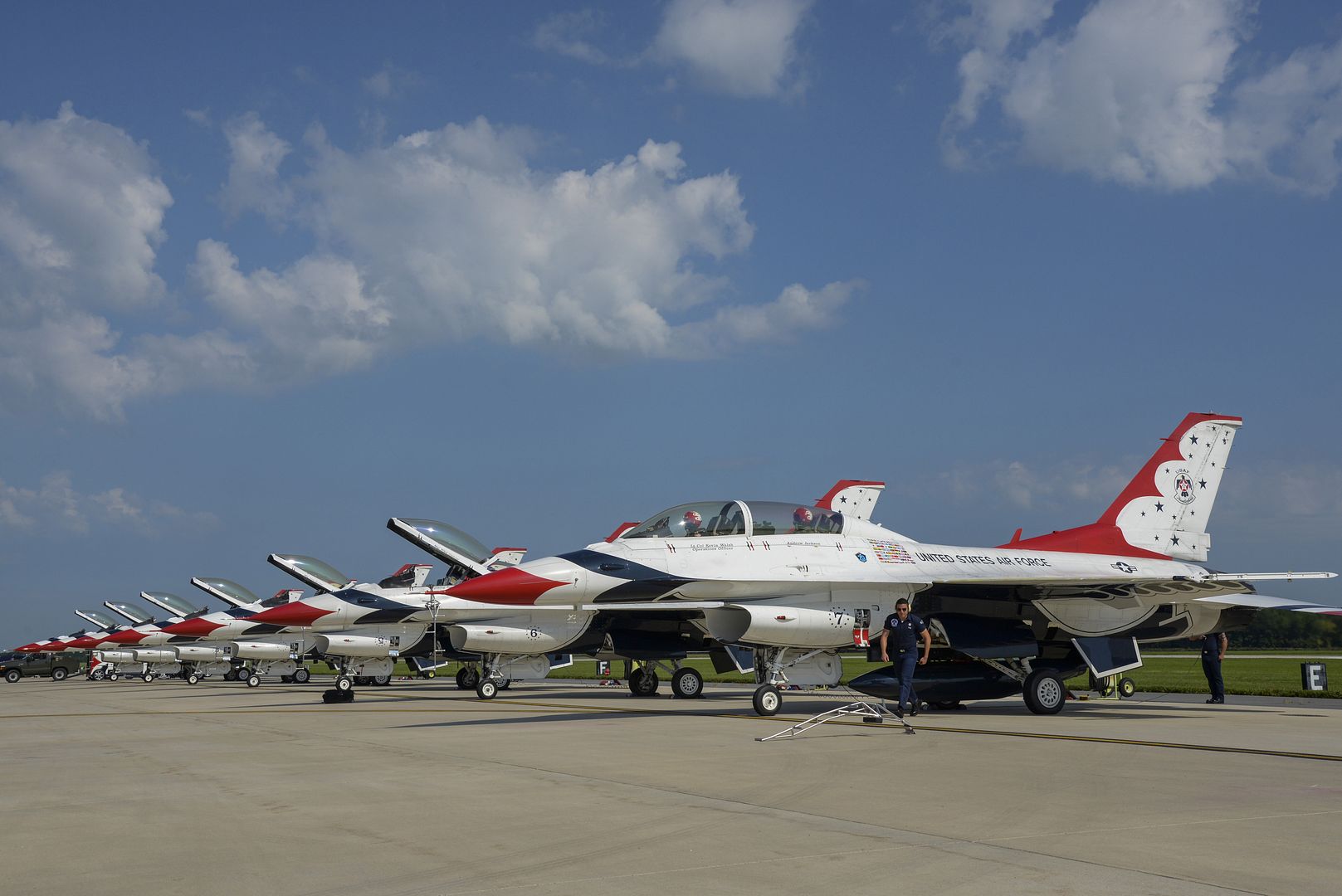
ATLANTIC OCEAN (Aug. 24, 2017) An MH-60R Sea Hawk helicopter assigned to the "Grandmasters" of Helicopter Maritime Strike Squadron (HSM) 46, Det. 1, takes off from the flight deck of the Arleigh Burke-class guided-missile destroyer USS Oscar Austin (DDG 79) Aug. 24, 2017. Oscar Austin is on a routine deployment supporting U.S. national security interests in Europe, and increasing theater security cooperation and forward naval presence in the U.S. 6th Fleet area of operations. (U.S. Navy photo by Mass Communication Specialist 2nd Class Ryan U. Kledzik/Released)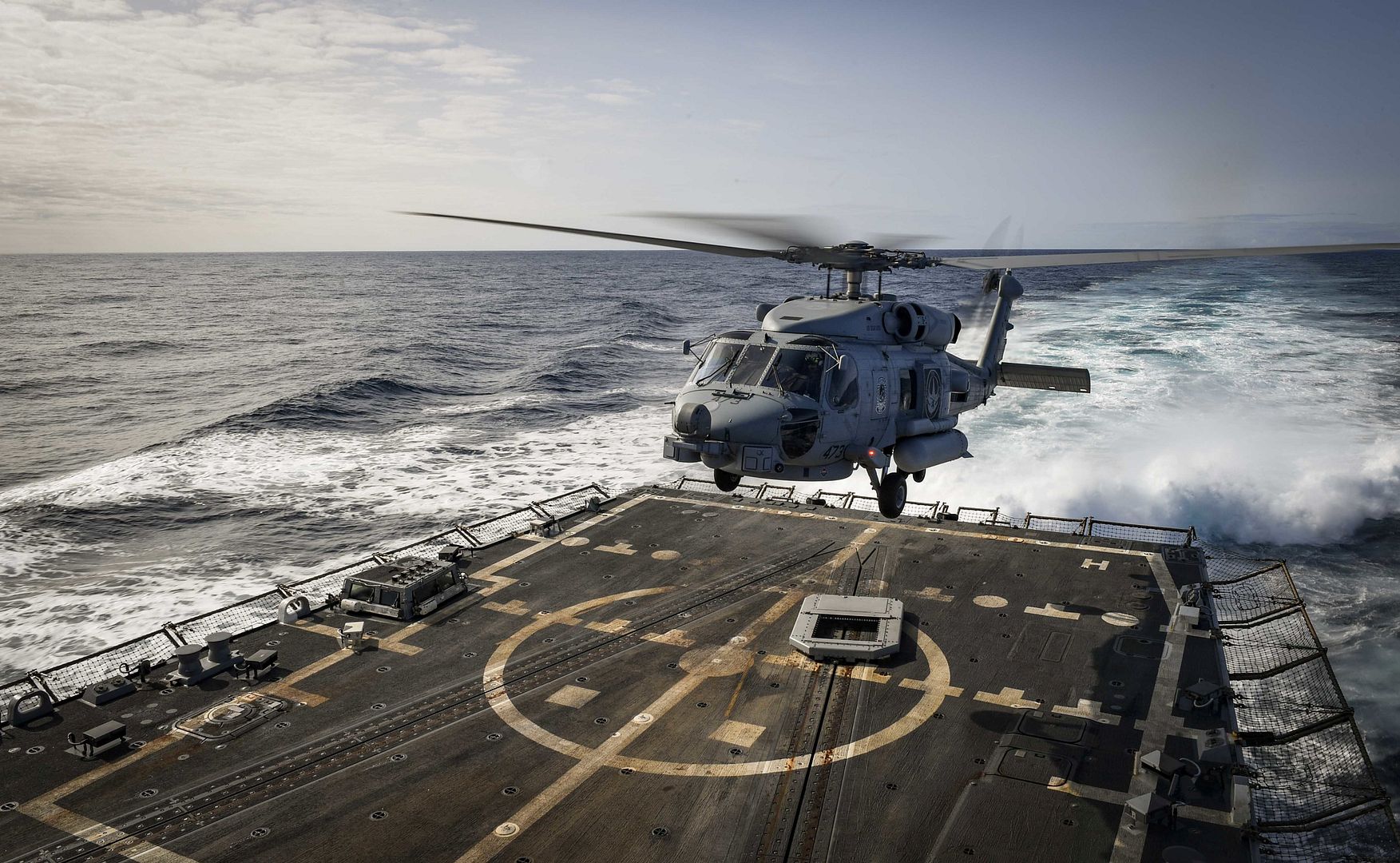
A U.S. Air Force F-22 Raptor prepares to receive fuel from a KC-135 Stratotanker, assigned to the 340th Expeditionary Air Refueling Squadron, during a mission in support of Operation Inherent Resolve Aug. 22, 2017. The F-22 is a component of the Global Strike Task Force, supporting U.S. and Coalition forces working to liberate territory and people under the control of ISIS. (U.S. Air Force photo by Staff Sgt. Michael Battles)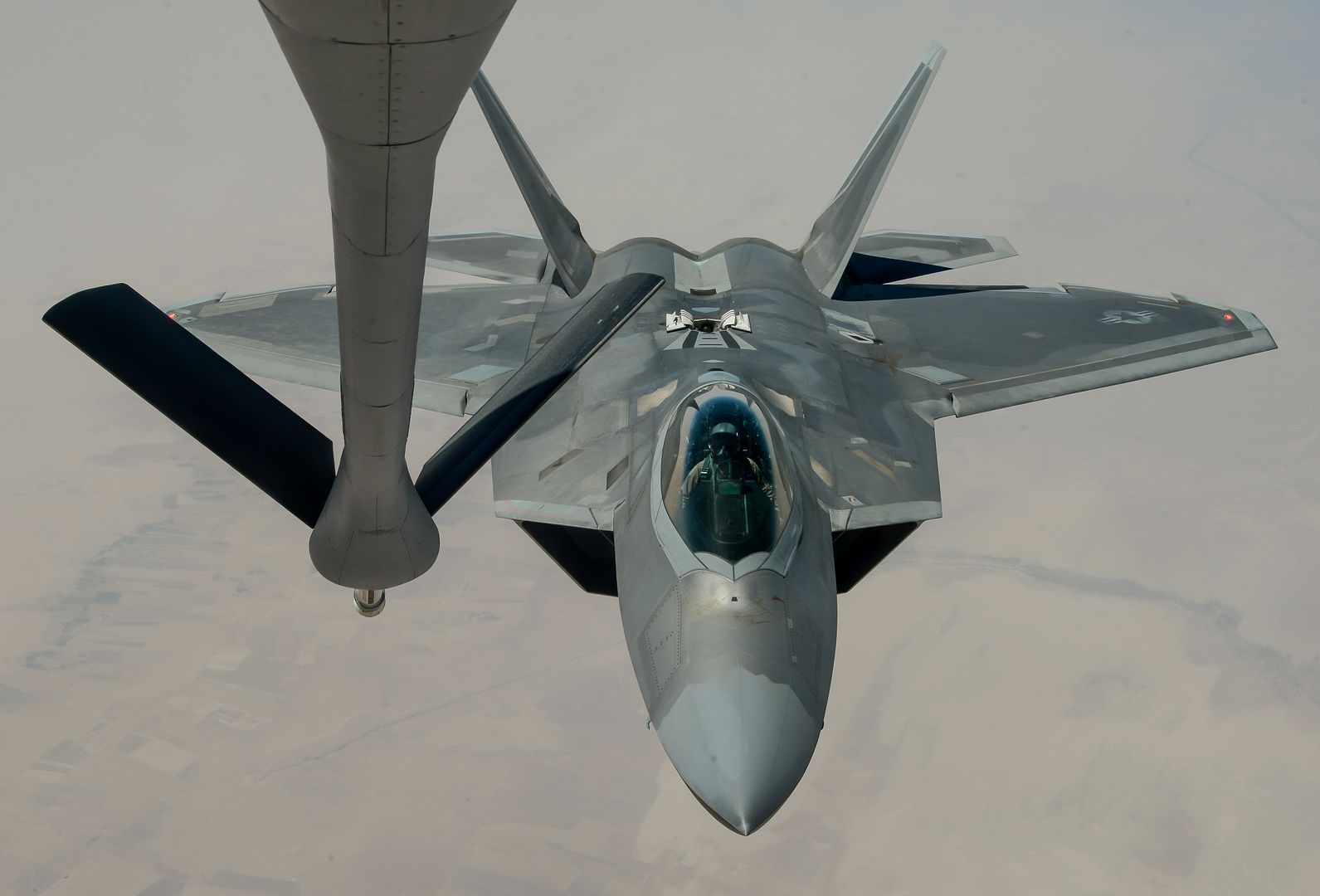
A U.S. Air Force F-22 Raptor departs after receiving fuel from a KC-135 Stratotanker, assigned to the 340th Expeditionary Air Refueling Squadron, during a mission in support of Operation Inherent Resolve Aug. 22, 2017. The F-22 is a component of the Global Strike Task Force, supporting U.S. and Coalition forces working to liberate territory and people under the control of ISIS. (U.S. Air Force photo by Staff Sgt. Michael Battles)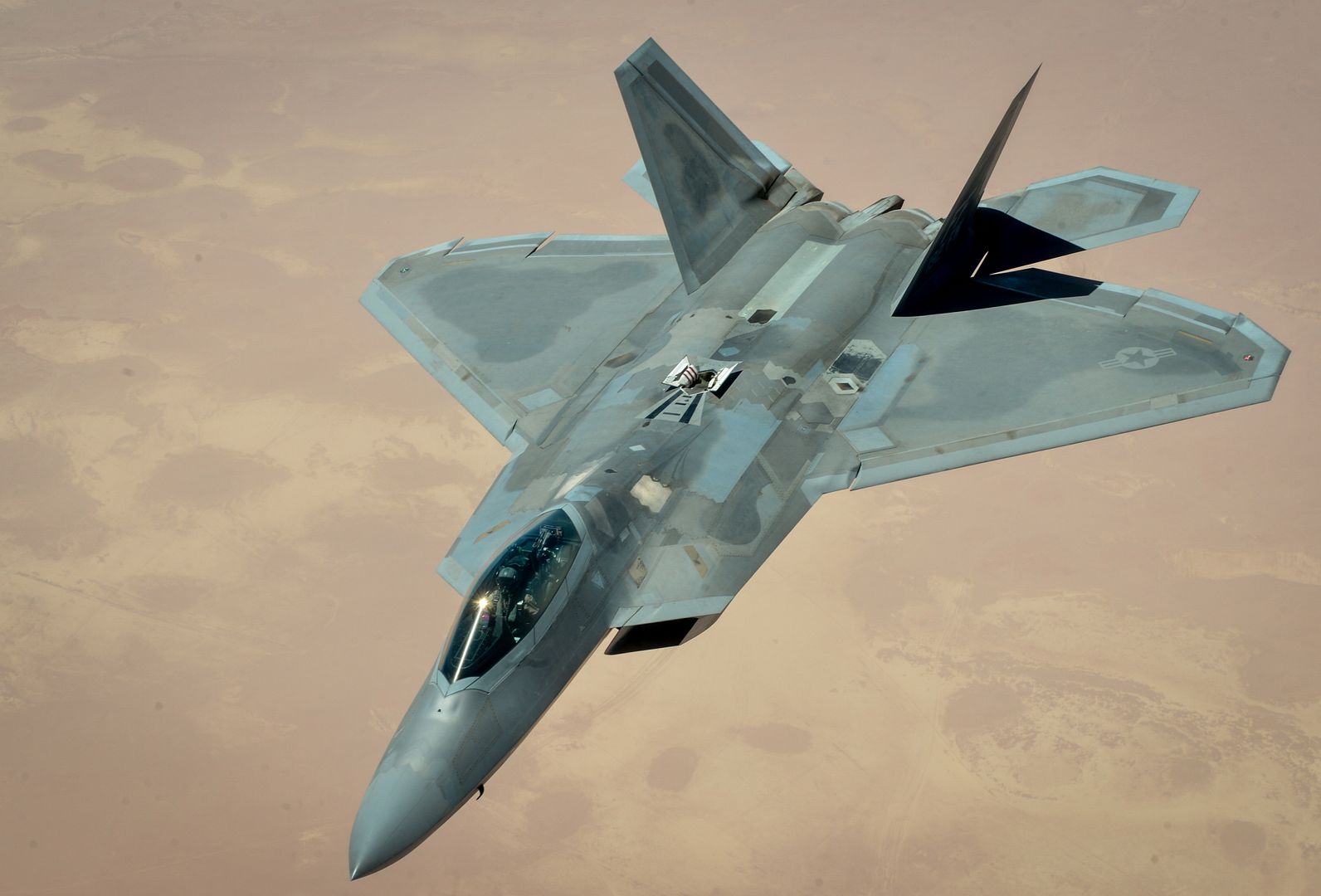
The early morning sun shines on Two B-1B Lancers at Royal Air Force Base Fairford, England, August 24, 2017. The jets, from the 7th Bomb Wing, are on hand for Ample Strike 2017, a Czech-led North Atlantic Treaty Organization training exercise. Not only does Ample Strike allow for greater cooperation between the U.S. and its NATO allies, it helps with the total force integration concept between active-duty Airman and their Reserve counterparts. (U.S. Air Force photo by Master Sgt. Ted Daigle/ released)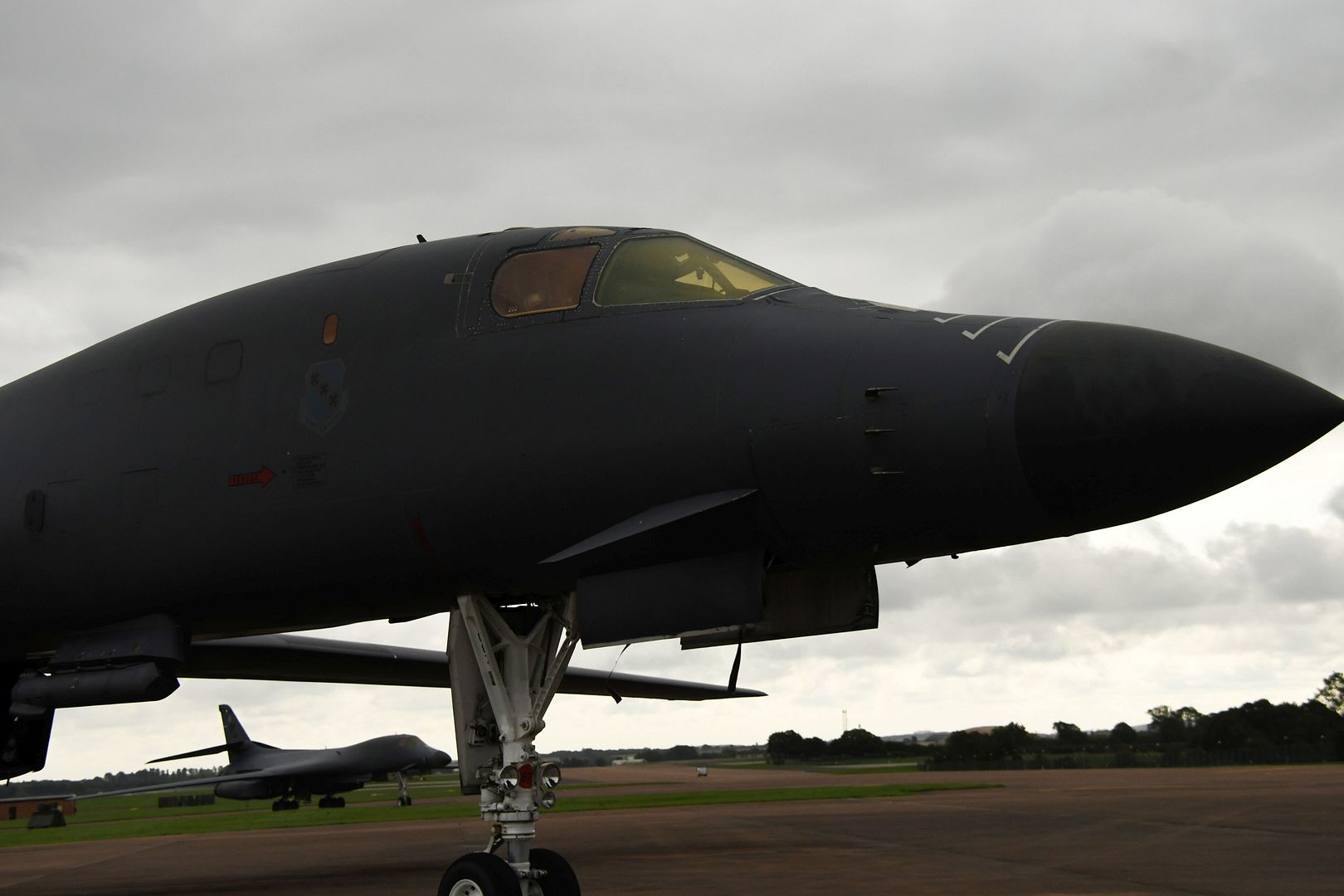
-
 Main Admin
Main Admin -
 Main AdminA Joint Base Elmendorf-Richardson C-17 Globemaster III accelerates for take-off on the flightline at JBER, Alaska, Aug. 28, 2017. Airmen of the Alaska Air National Guard?s 176th Wing will travel to Houston, Texas as part of a humanitarian mission in response to Hurricane Harvey. (U.S. Air Force photo by Senior Airman Javier Alvarez)
Main AdminA Joint Base Elmendorf-Richardson C-17 Globemaster III accelerates for take-off on the flightline at JBER, Alaska, Aug. 28, 2017. Airmen of the Alaska Air National Guard?s 176th Wing will travel to Houston, Texas as part of a humanitarian mission in response to Hurricane Harvey. (U.S. Air Force photo by Senior Airman Javier Alvarez)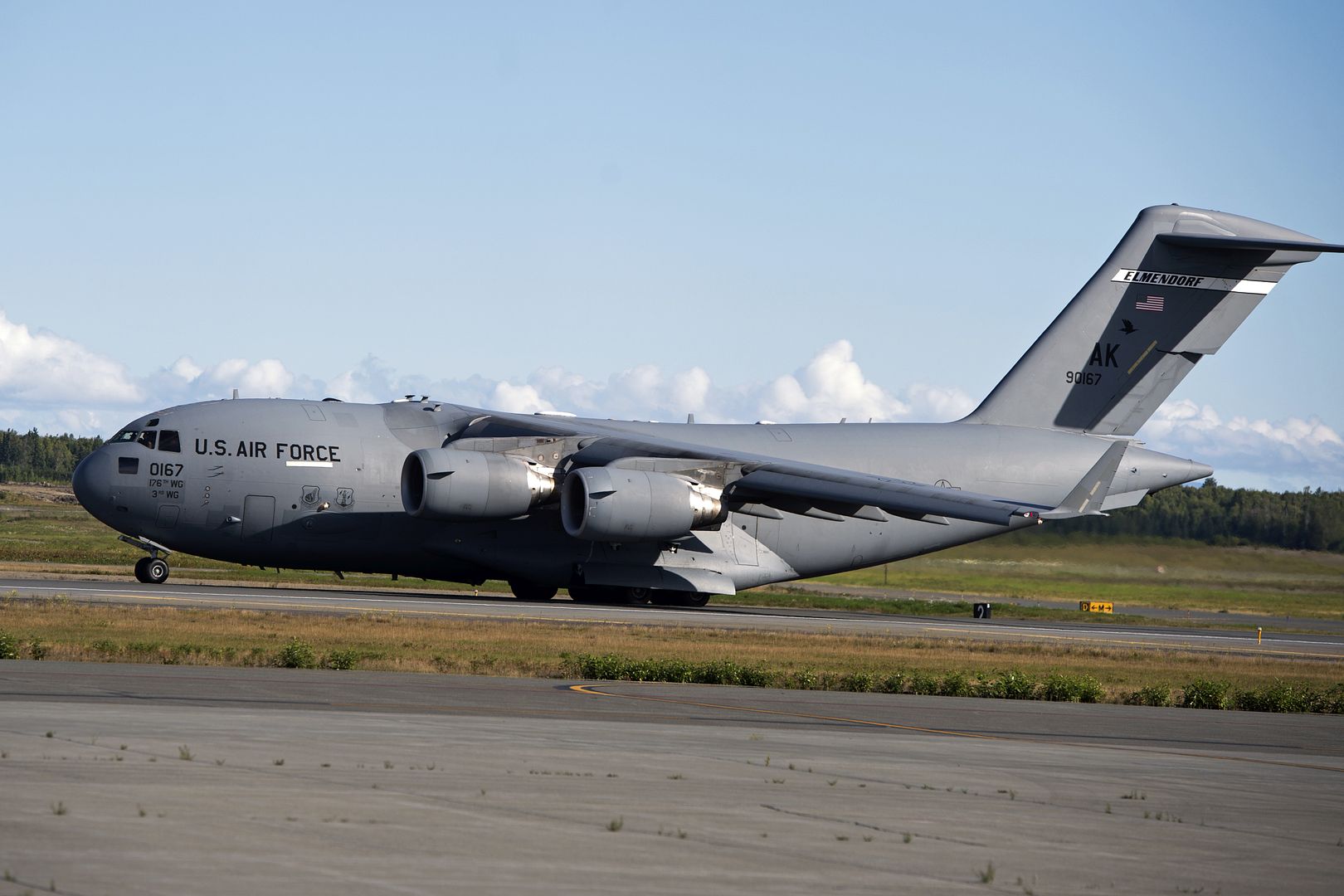
HC-130J Combat King II aircraft from the 71st Rescue Squadron sit on the flightline, Aug. 26, 2017, at Naval Air Station Fort Worth Joint Reserve Base, Texas. Aircraft and personnel from the 347th Rescue Group mobilized to NAS Fort Worth to assist in potential rescue efforts after Hurricane Harvey made landfall. The 347th RQG are in support of Air Forces Northern as part of Northern Command's support of FEMA's disaster response efforts. (U.S. Air Force photo by Staff Sergeant Ryan Callaghan)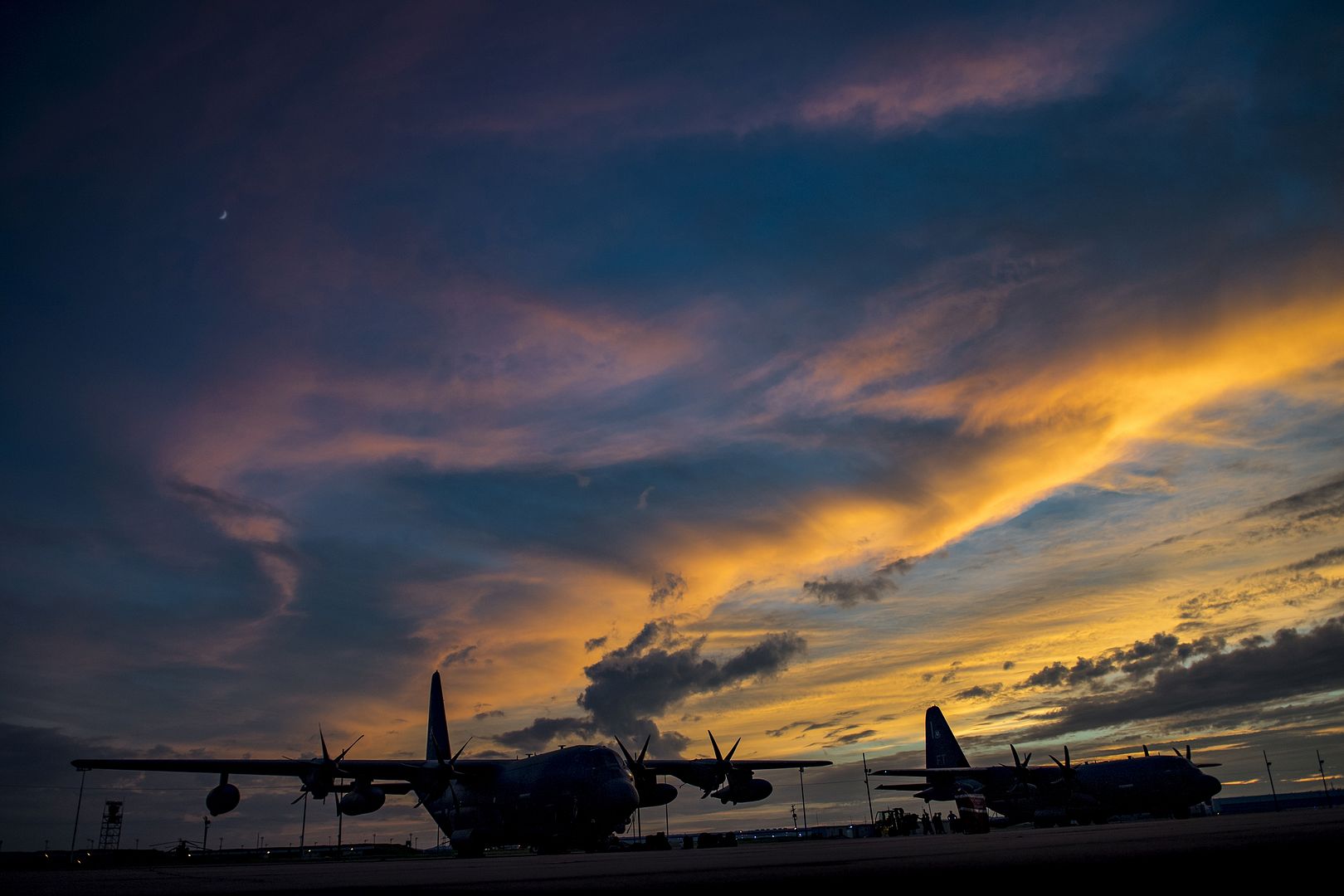
An HH-60G Pave Hawk, assigned to the 41st Rescue Squadron, rests on the flightline, Aug. 26, 2017, at Naval Air Station Fort Worth Joint Reserve Base, Texas. Aircraft and personnel from the 347th Rescue Group mobilized to NAS Fort Worth to assist in potential rescue efforts after Hurricane Harvey made landfall. The 347th RQG are in support of Air Forces Northern as part of Northern Command's support of FEMA's disaster response efforts. (U.S. Air Force photo by Tech. Sergeant Zachary Wolf)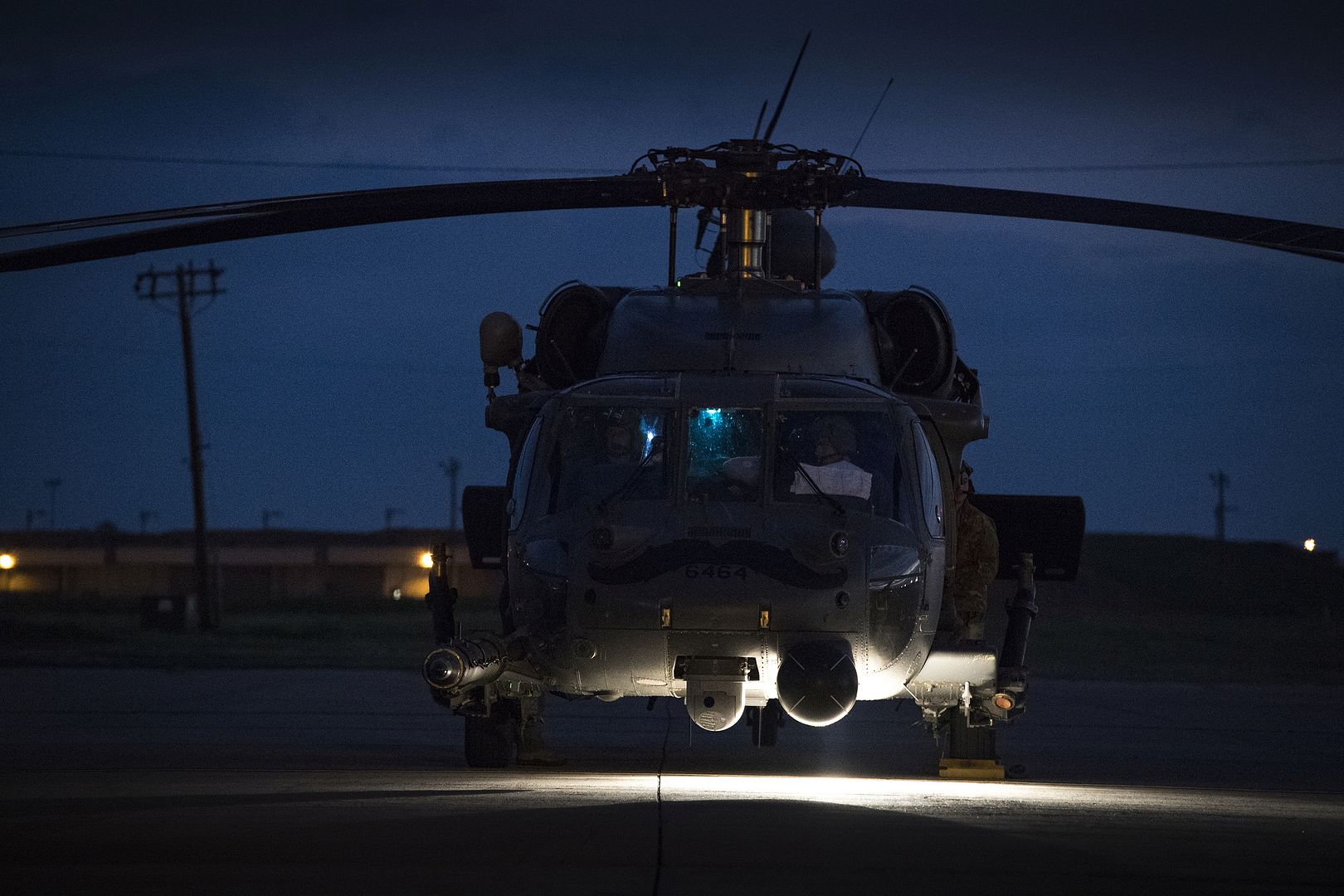
An Afghan Air Force Mi-17 departs to extract notionally wounded Afghan National Army soldiers during casualty evacuation training at Camp Shorabak, Afghanistan, Aug. 27, 2017. More than 60 soldiers with 7th Special Operations Kandak, 215th Corps and 215th Corps medics conducted casualty scenarios in preparation for real-world operations throughout Helmand province. Both forces increased their interoperability by refining their communications capabilities with one another and utilizing their four-line CASEVAC request, which is similar to the NATO nine-line procedure. (U.S. Marine Corps photo by Sgt. Lucas Hopkins)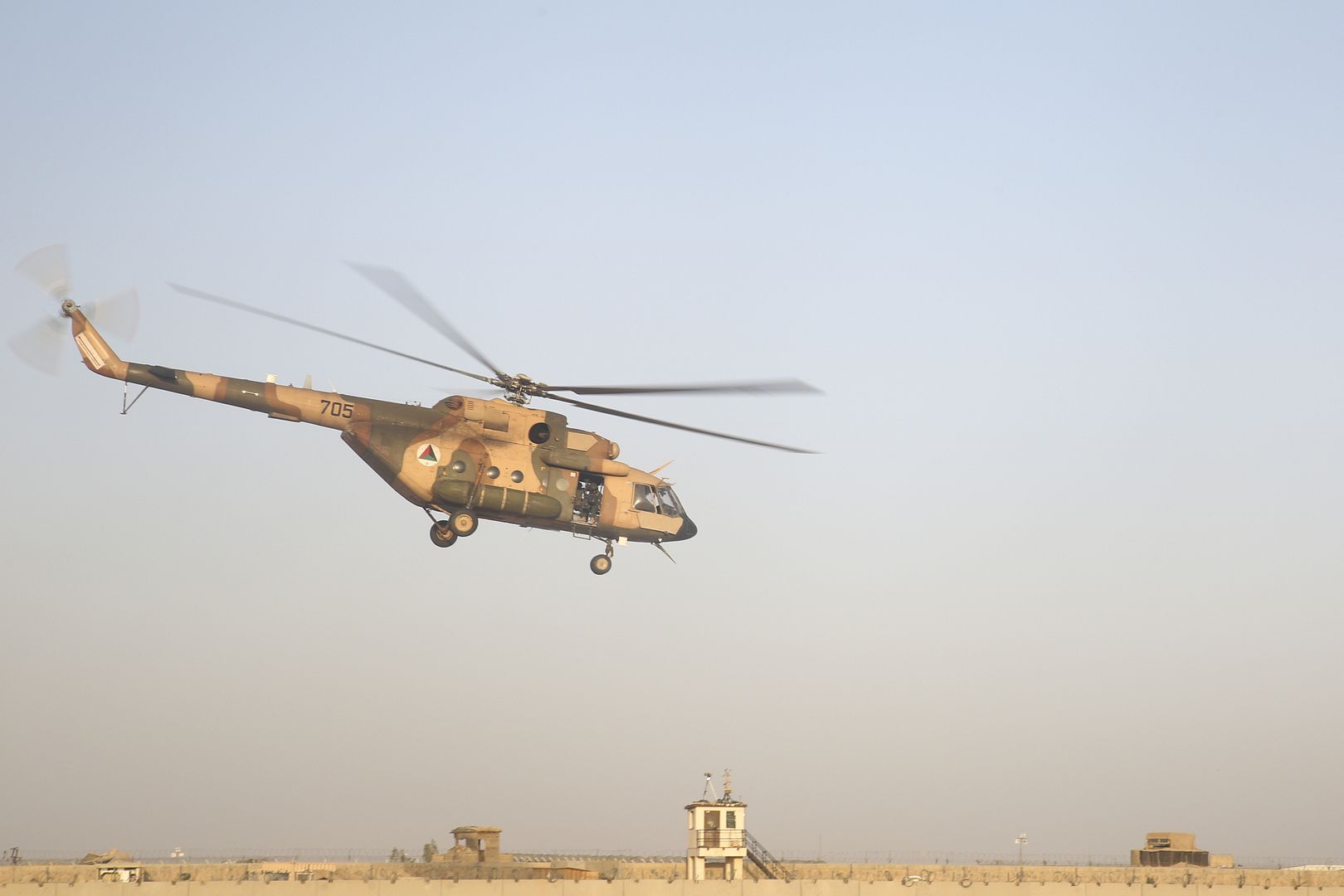
The first delivery of an A320 aircraft from the Airbus U.S. Manufacturing Facility has taken place in Mobile, Alabama, USA. The aircraft, delivered to Spirit Airlines, is the 37th overall delivery from the U.S. facility since production began in July 2015. The previous 36 aircraft were A321 aircraft, making this delivery another important milestone for Airbus.
Executives from Airbus and Spirit Airlines were on hand for the occasion.
Bob Lekites, Executive Vice President-Customers, Airbus Americas said: ?Airbus has reached another milestone in Mobile?delivery of the first A320 to be produced in the United States. Without a doubt, the A320 Family of aircraft meets the needs of our North American airline customers, and the 36 A321s already delivered from the U.S. have an extra special meaning for those airlines and their passengers. We?re pleased to celebrating this milestone with a great partner--Spirit Airlines.?
?Spirit Airlines is honored to receive the first Airbus A320 made in America,? said Ted Christie, Executive Vice President and Chief Financial Officer of Spirit Airlines. ?Our 106th aircraft, 650NK, will join Spirit?s growing Fit Fleet, the youngest and most fuel-efficient in the country. This new aircraft shows our commitment to delivering the cleanest, state-of-the-art aircraft to our customers as we continue to offer the lowest fares in the industry.?
The A320 Family is the world?s best-selling single-aisle product line and comprises four models (A318, A319, A320, A321) Typically seating 150 passengers in two classes, or up to 180 in a high-density layout for charter and low-cost operations, the A320 is in widespread service around the world, flying routes ranging from short commuter sectors to coast-to-coast U.S. flights. To date, the Family has won over 13,200 orders and more than 7,700 aircraft have been delivered to some 400 customers and operators worldwide.
Airbus announced its commitment to build a single-aisle assembly line in Mobile, Alabama in July 2012, and broke ground for the $600 million facility in April 2013. The ceremonial inauguration of the plant took place in September 2015. Airbus anticipates delivering four aircraft per month from the Mobile plant by the end of this year.
In addition to hundreds of new Airbus jobs the project has brought to the local community, the Mobile area has seen many Airbus suppliers open new facilities in the region, providing even more employment and a parallel boost to the local economy. Airbus is proud to say that more than 85 percent of its employees are from the Gulf Coast region, with nearly one third being U.S. military veterans.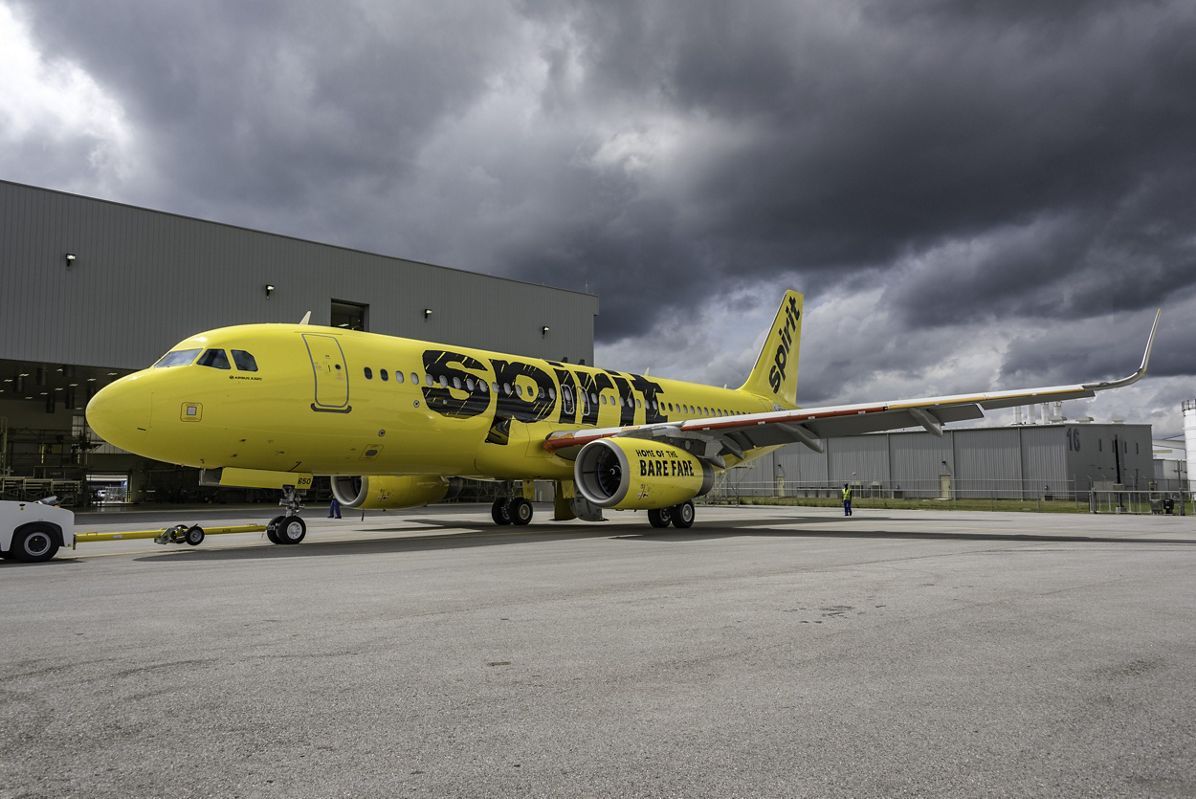
-
 Main AdminAn HC-130 search and rescue aircraft from the 106th Rescue Wing assigned to the New York National Guard returns to Fort Hood, Texas August 28, 2017. The C-130 was an instrumental part in the day's mission that helped 106th Airmen save 255 people and two dogs Houston. (U.S. Air National Guard photo by Daniel H. Farrell)
Main AdminAn HC-130 search and rescue aircraft from the 106th Rescue Wing assigned to the New York National Guard returns to Fort Hood, Texas August 28, 2017. The C-130 was an instrumental part in the day's mission that helped 106th Airmen save 255 people and two dogs Houston. (U.S. Air National Guard photo by Daniel H. Farrell)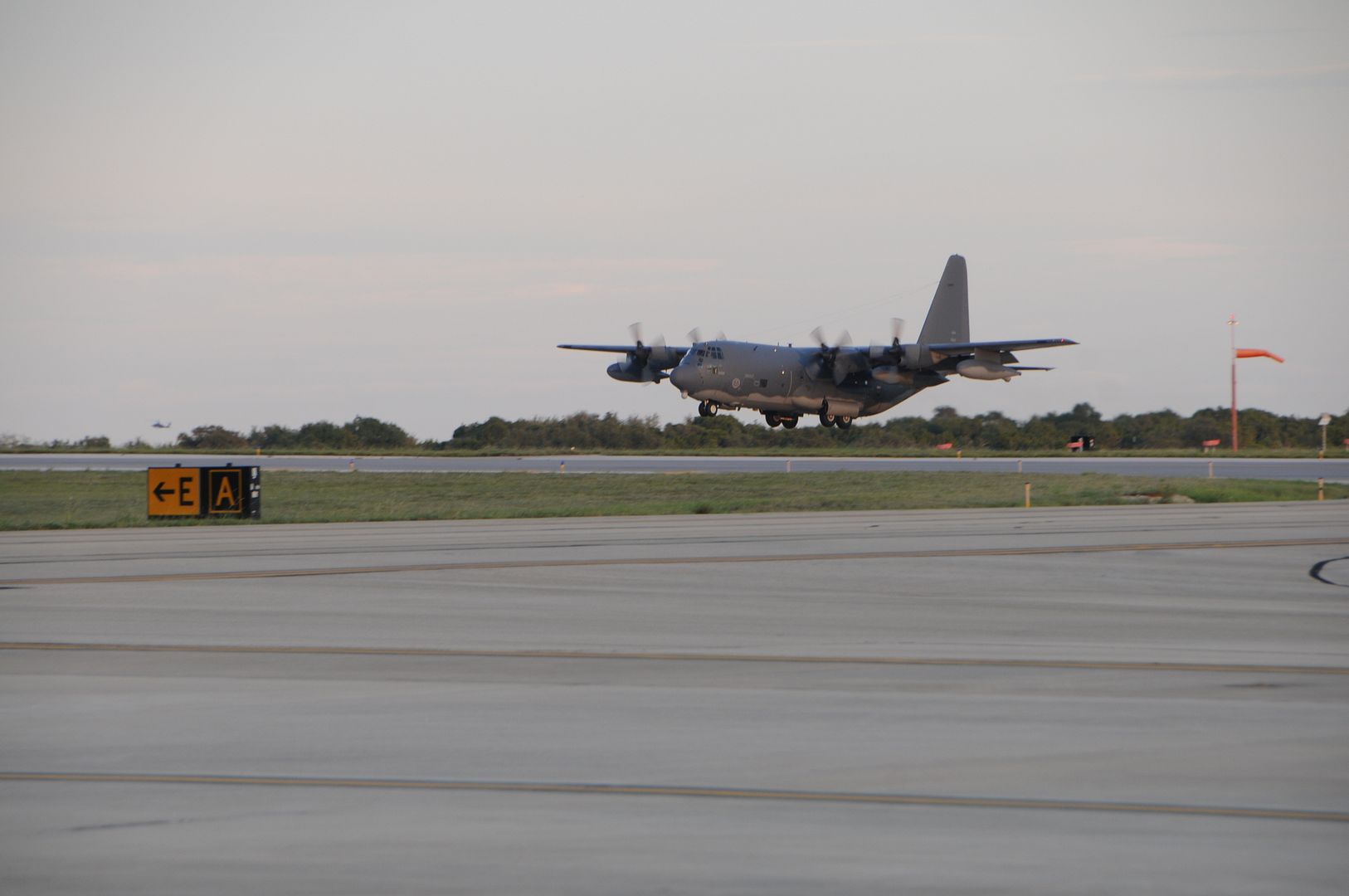
Disaster assistance personnel in support of recovery efforts from Hurricane Harvey arrive by Army C-12 at Naval Air Station Kingsville, Texas, on Aug. 28. (US Navy photo by Rod Hafemeister/Released)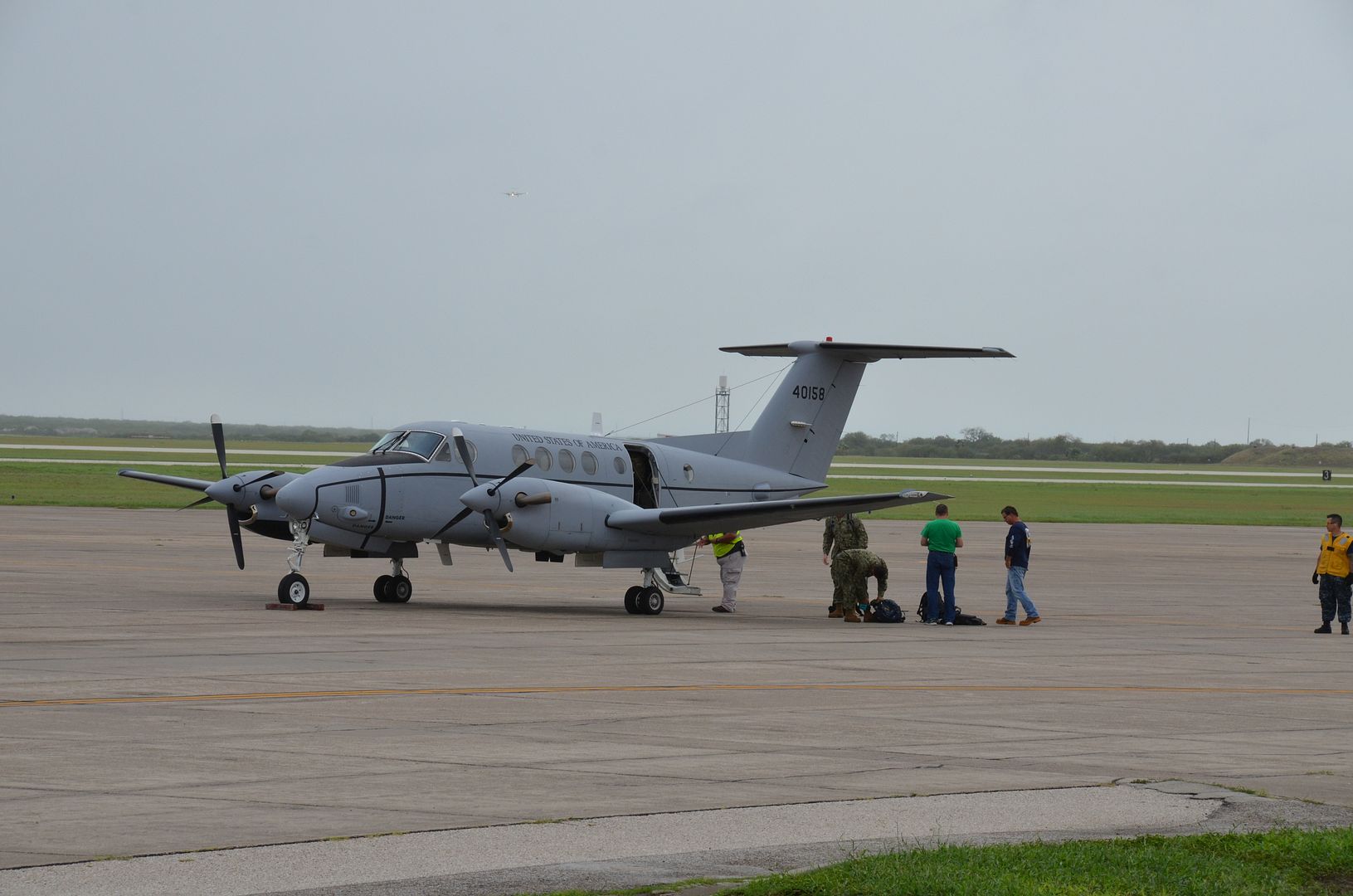
Archbald, Pa., Aug. 29, 2017 ? Lockheed Martin (NYSE: LMT) reached a significant program milestone by delivering its 100,000th Paveway II Plus Laser Guided Bomb (LGB) in support of enhancing U.S. and allies? munitions worldwide.
?Our high capacity production facility and streamlined manufacturing processes enable us to deliver the most cost-effective Paveway II Plus LGB guidance kits to meet the growing demand of global customers,? said Joe Serra, precision guided systems director at Lockheed Martin Missiles and Fire Control. ?Sixteen nations and the U.S. Air Force now use our combat-proven LGB kits as a critical component of their defense strategy.?
A qualified supplier of Paveway II LGB kits since 2001, Lockheed Martin continues to expand its production capabilities to improve efficiency, and, as a result, has driven down average unit prices by 45 percent. In the last eight annual competitions, the U.S. Air Force and its foreign military sale partners have selected Lockheed Martin to provide the majority of their LGB kits.
Paveway II Plus includes an enhanced guidance package that improves accuracy over legacy LGBs. Qualified for full and unrestricted operational employment in GBU-10, -12 and -16 (2,000-lb./500-lb./1,000-lb.) configurations, Paveway II Plus is cleared for use on U.S. Air Force, U.S. Navy and international aircraft authorized to carry and release LGBs.
In addition to the Paveway II Plus LGB, Lockheed Martin's 350,000-square-foot production facility in Archbald, Pennsylvania, is the sole provider of the Enhanced Laser Guided Training Round and Paragon? direct-attack munition. Lockheed Martin has delivered more than 160,000 training rounds and 7,000 dual-mode LGB kits to the U.S. Navy, Marine Corps, Air Force and 23 international customers. Approximately 175 employees at Lockheed Martin?s Orlando, Florida, and Archbald, Pa., Missiles and Fire Control facilities support the Precision Guided Systems programs.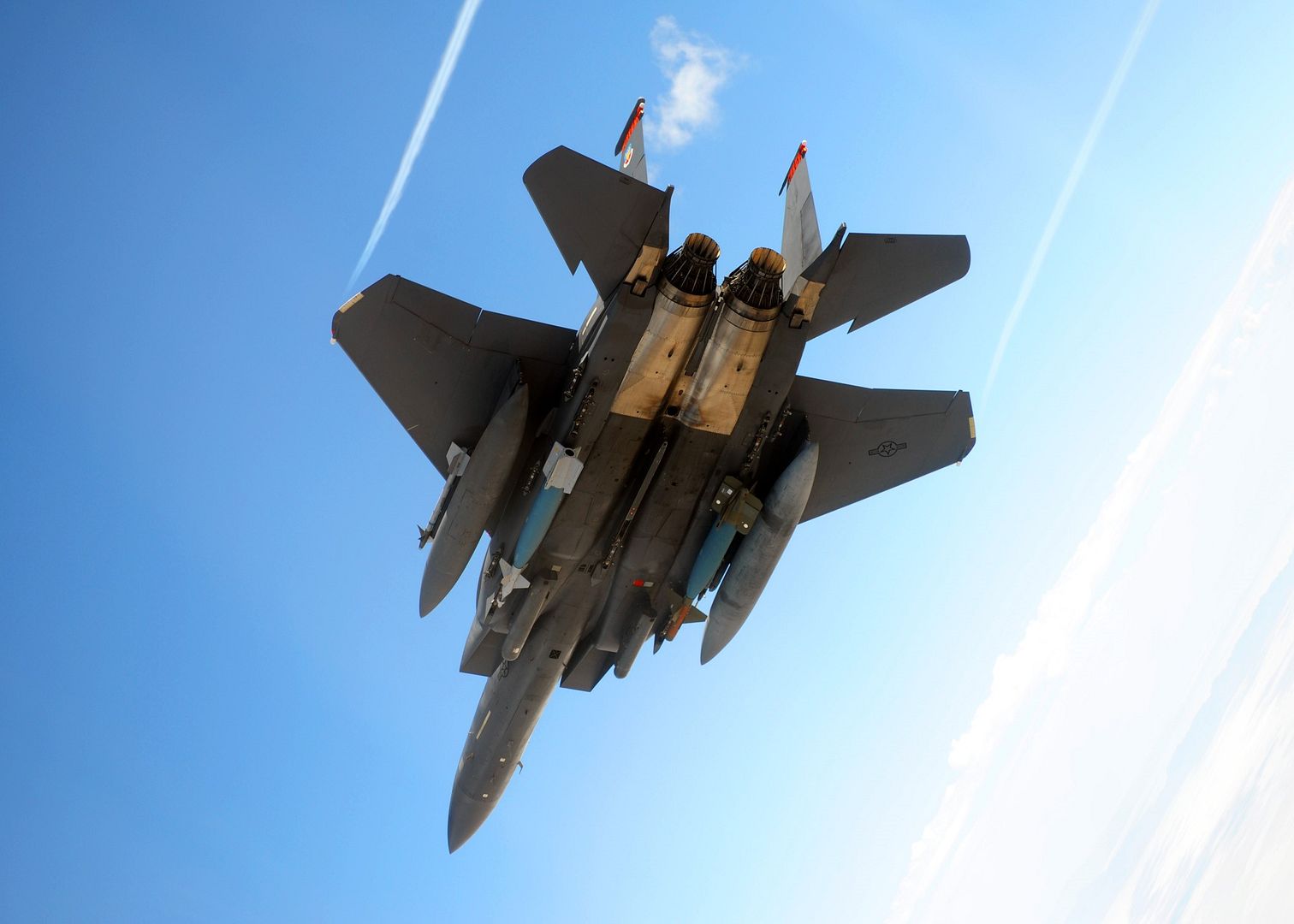
Two Royal Air Force Typhoon Aircraft from 3 (Fighter) Squadron have arrived in Estonia to conduct a training mission.
The aircraft have arrived to conduct Air Land integration training with the British Army Battlegroup currently deployed in Estonia as part of the NATO Enhanced Forward Presence Operation.
The Typhoons having transitted from Romania where they have just completed their NATO Enhanced Air Policing mission, will be carrying out this training before returning to the UK.
Squadron Leader Paul Hanson, one of the pilots said "This deployment proves our ability to move fast jets from NATO's south eastern flank to the Baltic region in a matter of hours, demonstrating the flexibility of airpower to reassure our Allies at short when required to do so."
Photo Credit - Sgt Ralph Merry
-
 Main Admin08.30.2017
Main Admin08.30.2017
A Coast Guard Air Station Clearwater HC-130 rescue crew offloads supplies and aircrew personnel at Coast Guard Aviation Training Center Mobile in support of Hurricane Harvey relief efforts. The Coast Guard has deployed assets and resources from across the country to create a sustainable response force. (Coast Guard Courtesy photo).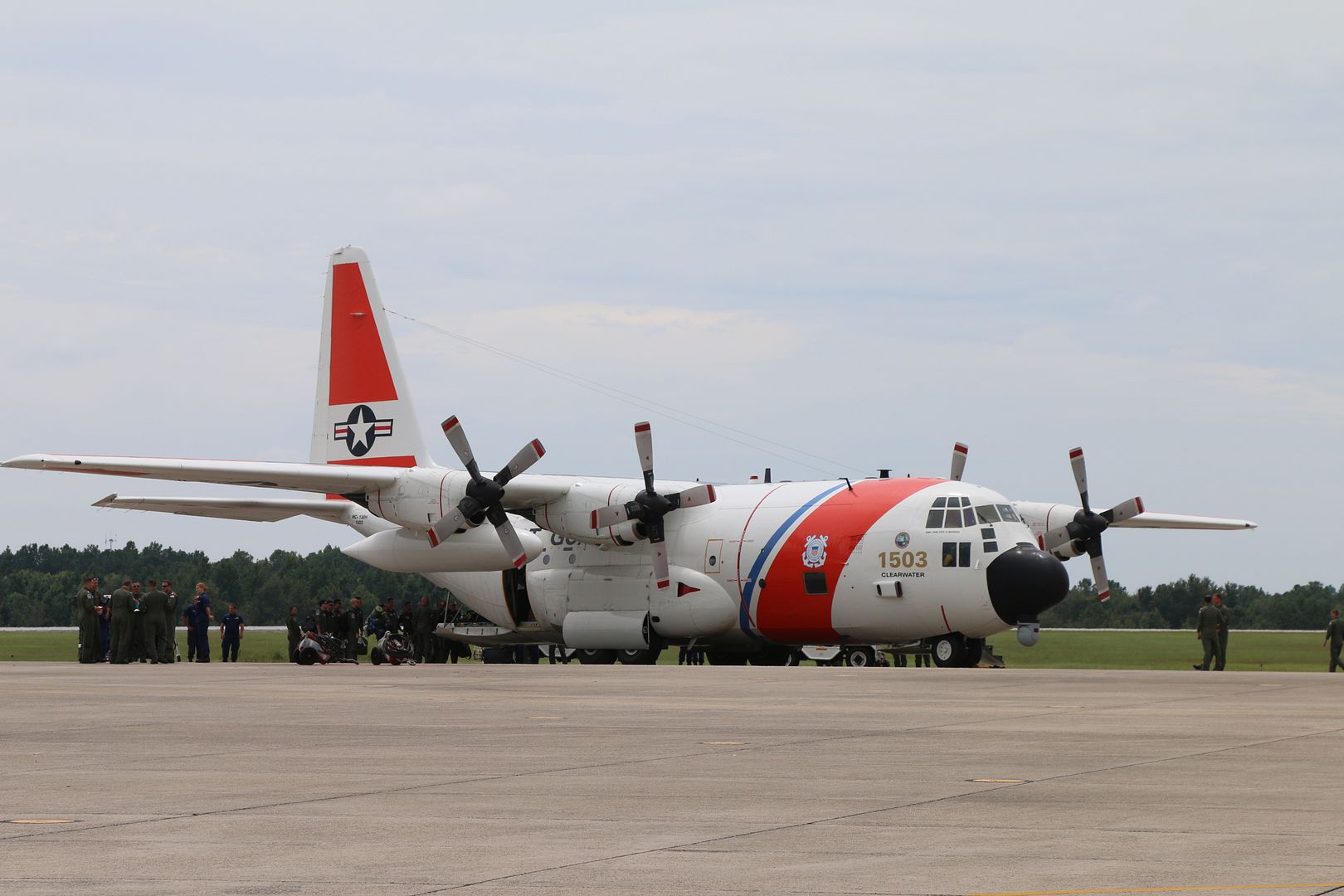
EDWARDS AIR FORCE BASE, Calif. -
Sierra Nevada Corporation?s Dream Chaser underwent a captive carry test at NASA?s Armstrong Flight Research Center today at Edwards Air Force Base. The test was part of the spacecraft?s Phase Two flight test efforts to advance the orbiter closer to space flight, according to an SNC press release.
A Columbia Helicopters Model 234-UT Chinook helicopter carried the Dream Chaser over Edwards for about an hour. The goal was to reach an altitude and flight conditions the spacecraft would experience before being released on a free flight test, said company officials.
The Dream Chaser was delivered to Armstrong Jan. 25 to undergo several months of testing at the center in preparation for its upcoming approach and landing flight on one of Edwards AFB?s runways.
The test series is part of a developmental space act agreement SNC has with NASA?s Commercial Crew Program. The test campaign will help SNC validate the aerodynamic properties, flight software and control system performance of the Dream Chaser, according to NASA.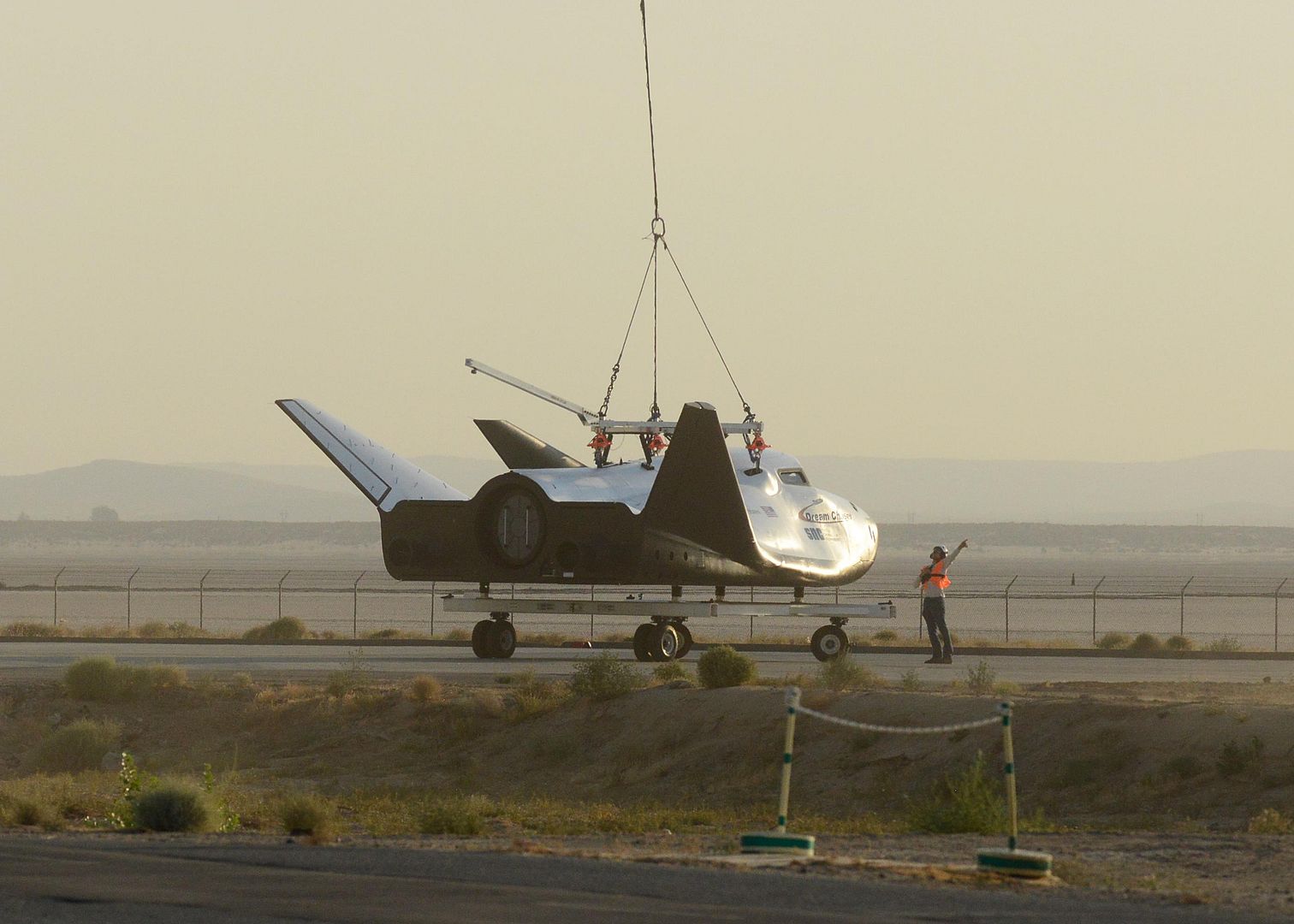
Through a press release, Lee Archambault, SNC director of flight operations for the Dream Chaser program, said, ?We are very pleased with the results from the captive carry test and everything we have seen points to a successful test with useful data for the next round of testing.?
The captive carry test today is one of two planned at Edwards for this year. Today?s test obtained data and evaluated both individual and overall system performance, said the release. If the second captive carry test is a success, it will clear the way for a free-flight test.
The Dream Chaser is also being prepared to deliver cargo to the International Space Station under NASA?s Commercial Resupply Services 2 contract beginning in 2019. The data that SNC gathers from this test campaign will help influence and inform the final design of the cargo Dream Chaser, which will fly at least six cargo delivery missions to and from the space station by 2024, according to NASA.
AUAI, Hawaii (Aug. 29, 2017)
A medium-range ballistic missile target is launched from the Pacific Missile Range Facility in Kauai, Hawaii, during Flight Test Standard Missile-27, Event 2. The target was successfully intercepted by SM-6 missiles fired from the guided-missile destroyer USS John Paul Jones (DDG 53). U.S. Navy photo by Latonja Martin (Released)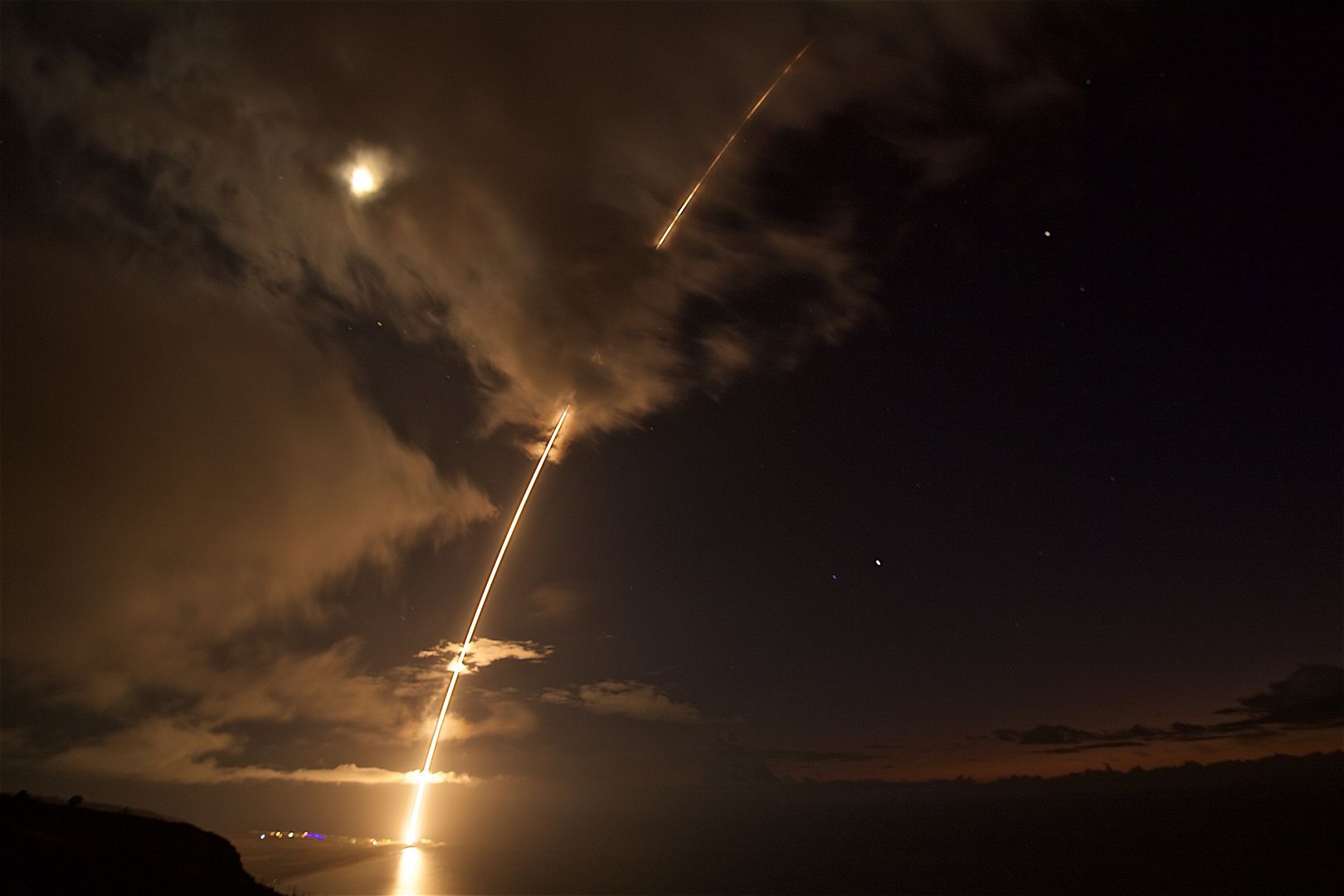
Post a reply
- Go to Previous topic
- Go to Next topic
- Go to Welcome
- Go to Introduce Yourself
- Go to General Discussion
- Go to Screenshots, Images and Videos
- Go to Off topic
- Go to Works in Progress
- Go to Skinning Tips / Tutorials
- Go to Skin Requests
- Go to IJAAF Library
- Go to Luftwaffe Library
- Go to RAF Library
- Go to USAAF / USN Library
- Go to Misc Library
- Go to The Ops Room
- Go to Made in Germany
- Go to Campaigns and Missions
- Go to Works in Progress
- Go to Juri's Air-Raid Shelter
- Go to Campaigns and Missions
- Go to Works in Progress
- Go to Skinpacks
- Go to External Projects Discussion
- Go to Books & Resources
